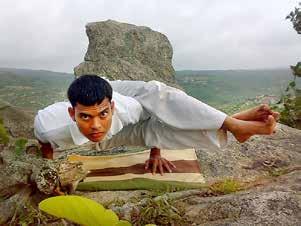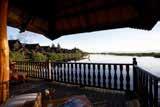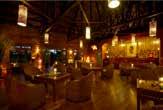














The Irrawaddy magazine has covered Myanmar, its neighbors and Southeast Asia since 1993.
EDITOR-IN-CHIEF: Aung Zaw
EDITOR (English Edition): Kyaw Zwa Moe
ASSOCIATE EDITOR: Sandy Barron
COPY DESK: Paul Vrieze; Andrew D. Kaspar; David Kay; Feliz Solomon; Sean Gleeson
CONTRIBUTORS to this issue: Kyaw Zwa Moe; Sandy Barron; Nyein Nyein; Kyaw Hsu Mon; Hnin Wathan; Whitney Light; Claudia Sosa; Bertil Lintner; Kenneth Wong; Samantha Michaels; Yen Snaing; Simon Lewis; Lawi Weng; Seamus Martov; Nobel Zaw; Nan Lwin Hnin Pwint.
PHOTOGRAPHERS: JPaing; Sai Zaw; Hein Htet; Teza Hlaing; Steve Tickner; Timo Jaworr
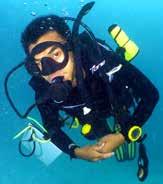
LAYOUT DESIGNER: Banjong Banriankit
SENIOR MANAGER : Win Thu (Regional Office)
MANAGER: Phyo Thu Htet (Yangon Bureau)
REGIONAL HEADQUARTERS MAILING ADDRESS: The Irrawaddy, P.O. Box 242, CMU Post Office, Chiang Mai 50200, Thailand.
YANGON BUREAU : Building No 170/175, Room No
806, MGW Tower, Bo Aung Kyaw Street (Middle Block), Botataung Township, Yangon, Myanmar.
TEL: 01 388521, 01 389762
EMAIL: editors@irrawaddy.org
SALES&ADVERTISING: advertising@irrawaddy.org
SUBSCRIPTIONS: subscriptions@irrawaddy.org
PRINTER: Chotana Printing (Chiang Mai, Thailand)
PUBLISHER LICENSE : 13206007060120
With nascent political changes in Myanmar, dissidents in exile face a tough choice on whether to return
|
The Western policy of engagement with Myanmar has been touted as a success, but for whom?
25 |
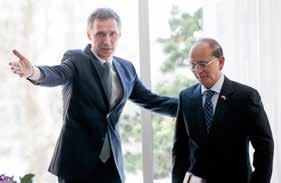
Drug-resistant malaria may be “jumping” from place to place, or “popping up” independently — either way the strategy to fight it is taking on a new urgency
|
Centenarian U Khan is proud of the excting, if small part he played in Myanmar’s history



|
The remote archipelago is slowly revealing its treasures — and vulnerabilty
|
|
Growers hope to take the sector to a new level
|
Card payments are gaining in popularity
Villagers, small businesses frustrated as expected tourism boom is delayed
50 | Signposts: Mining Law Delays
 By NYEIN NYEIN / YANGON
By NYEIN NYEIN / YANGON
His pupils describe him as “brilliant” and “incredible” and when you listen to him speak the Myanmar language with the ease and fluency of a local, it’s easy to see why.
John Okell has taught the Myanmar tongue for over five decades. Now 80, the British lecturer’s passion for the language has not diminished and the classes he runs twice a year—in Chiang Mai, Thailand and in Yangon—are highly sought after by prospective students.
His long association with the language began fortuitously in 1959 when he inquired about courses through the British foreign office.

“They were looking for someone to be taught Burmese,” Mr. Okell recalled. “I applied to the program as I was interested in languages and they chose me and trained me.”
After one and a half years of study at SOAS, University of London with teacher Dr. Hla Pe and phonetic lecturer Keith Sprigg, he was sent to Myanmar to practice his blossoming language skills.
He stayed in the country for one year from 1960, including a month-long stay in a village in Amarapura in central Myanmar where he learned more about the intricacies of the language and the local culture.
“I was lucky that Saya Hla Pe was very kind and introduced me to a lot of friends,” Mr. Okell said.
He returned to teach Myanmar at the SOAS and to foreign diplomats, while also making frequent trips to the country at least every five years.
Following his retirement at 65, Mr. Okell was invited by foreigners working on Myanmar issues in Thailand to provide them with language training—a role he still performs passionately today.
Former student Marisa Charles, a senior program manager at the Myanmar Institute for Integrated Development, took classes under Mr. Okell in 2008, 2009 and 2011 in Chiang Mai.
“He is a true teacher at heart,” she said of Mr. Okell. “He always has an interesting or funny quip or story to help us understand the history from which the language emerged, and the playful way that Myanmar people creatively use their language today.”
Gabrielle Galanek, another former student and now a communications consultant in Bangkok, spoke of Mr. Okell’s love of the language.
“His passion was infectious. He spoke so eloquently about the details of the language and how fascinating the structure was, the tones,” she said.
In 2009, Mr. Okell was invited to teach three-week intensive classes in Yangon. But he was initially reluctant. “I felt ashamed as they have got plenty of Burmese around them, [while] I was offered to go and teach.”
But his pupils say they are grateful to have him, as are other lecturers in the language.
“When you study with John, the last thing you want to do is disappoint him, so in that way he’s one of the most inspiring and motivating teachers I’ve ever met,” said Kirt Mausert, senior program trainer for the Institute for Political and Civic Engagement based at the American Center.
Mr. Mausert was first introduced to the renowned language teacher in a bookstore on Yangon’s Bogyoke Aung San Road where he found a copy of Mr. Okell’s “First Steps in Burmese.”
“John is by far the most patient and understanding teacher of any subject I’ve ever seen. His passion for teaching Burmese inspires all of his students,” said Mr. Mausert, who is now Mr. Okell’s course coordinator in Yangon.
According to Ma Yamin Shwe Sin Htaik, a Myanmar language lecturer at Chiang Mai University, Mr. Okell is “the best teacher” among foreigners teaching the language. He knows the language deeply, she said, and although he speaks in very polite Myanmar, he is not old fashioned and keeps up to date with new words whenever he can.
“He has an encyclopedic knowledge of the language that is unparalleled,” Mr. Mausert said.
“Although, since he is also a paragon of humility, I expect he would be the first to claim that his knowledge of the language is far from perfect.”
Aside from the educational language books and scholarly articles he has written, Mr. Okell has no interest in penning an autobiography, despite the fascinating life of teaching and learning he has led. “It is not very interesting” to write about oneself, he said.
Although he lives for most of each year in England, he is well-connected with the Myanmar community and is knowledgeable about currrent Myanmar affairs.
Asked his opinion on recent developments in the country, he remarked: “I think the most striking change has been free speech. At one time, people were nervous about what they said.”
“Other changes you have is the different economic situation, better income, more choice of goods and services. [But] most people I know are saying all of them [the reforms] are the same as before,” he said.
Another difference he has noticed is that these days on the streets of Yangon, people will speak to him in Myanmar whereas when he first arrived in the then-capital, more than 50 years ago, Yangon residents invariably addressed him in English.
‘‘He spoke so eloquently about the details of the language and how fascinating the structure was, the tones.’’
—Mi Than Shin, chairwoman of the Women’s Party, told The Irrawaddy that the proposed political party would not bow to the government’s request that they change their name to something “more specific.”

—Naw Susanna Hla Hla Soe, director of the Karen Women’s Action Group (KWAG) slams the leadership of the Karen National Union for neglecting civil society voices in a comment to The Irrawaddy.
—Daw Hlaing Maw Oo, an architect and director from the Ministry of Construction, speaking at the “Save our Shwedagon” forum on the potential for high-rise buildings to obscure the revered site.

“We cannot accept the name change. If we cannot register under our name, at worst we will not be able to contest.”
“There is no transparency regarding their doings... We want them to have transparency and sincerity in working for peace.”
“The more visual pollution we have, the faster we will lose the view of the great pagoda for the next generation.”

Six activists who attempted to protest last December at the Chinese Embassy in Yangon over a deadly police crackdown at the Letpadaung copper mine were each sentenced on May 15 to four years and four months in prison.
The heavy sentences were handed down by the Dagon Township Court to three male activists—U Nay Myo Zin, U Tin Htut Paing and U Than Swe— and three female activists—Daw Naw Ohn Hla, Daw Sein Htwe and Daw San San Win, also known as Lay Lay.

The activists received
sentences of one year under the Penal Code’s Article 147, which covers rioting; one year for Article 353, pertaining to assault or use of criminal force to deter a public servant from discharging his or her duty; and two years under Article 505(b), for making statements causing undue public fear or alarm.
The additional four months were tacked on for violating Article 18 of the Peaceful Assembly Law, which states that activists need government permission to hold a protest.
Nearly 100 people participated in a march to the Chinese Embassy on Dec. 29 where they had intended to lay wreathes as a tribute to Daw Khin Win, a woman in her 50s who was shot dead by police during a protest at Letpadaung.
Nobel ZawA lead mine near Tanintharyi Region’s Kalonehtar village has temporarily ceased operations after villagers asked the mine’s owners to stop polluting the area’s only water source.
Over 100 villagers visited the mine on May 16 to request ANA&NRD Company—which has run the mine since 2000—halt production. The mine’s waste products, disposed of nearby, had earlier this year begun to make their way into the Talaingyar stream after soaking into the topsoil at a dumpsite.
Daw Tin Than, a midwife living in the village, said that locals were concerned the polluted water would damage nearby orchards once the rainy season begins.
“The downstream water has become muddy now and we can’t catch fish anymore,” she told The Irrawaddy. “We asked them to stop their work until they fix the damage caused to the village.”
Villagers have requested that the company improve its waste management practices and build a filtered water tank in Kalonehtar, home to about 200 households. The 407th Myanmar Army Battalion, stationed nearby, has also approached the company about the polluted stream, which it relies upon for bathing, drinking and cooking.
“The soil and other waste from the mine is like a mountain now,” said Ko Ye Lin Myint of the Dawei Development Association. “When it rains, this soil will block the stream and change the water flow… The company is using diesel and coal tar in the mine, and the waste water is being disposed of in the stream as well.” —Yen Snaing
reform and a cessation of hostilities on the country’s northeast and western frontiers at the conclusion of a six-day summit in Wa Special Region from May 1-6.
Representatives of 12 ethnic armed groups said the country’s decades-long civil war can only be solved through political dialogue following the adoption of a nationwide ceasefire agreement (NCA).
Ethnic rebel leaders called on the government to prove its commitment to peace through constitutional
While President U Thein Sein announced on May 4 that the government was “ready to sign” the NCA draft, Wa spokesman Aung Myint said at a closing ceremony that ethnic leaders will convene

again before talks can continue with the government, though no date was set.
A statement unanimously endorsed by attendees urged the government to stop assaults in Kachin, Ta’ang, Kokang and Rakhine territories, warning that the attacks undermined trust and endangered the prospect of durable peace.
Chief ethnic negotiator Nai Hong Sar, head of the Nationwide Ceasefire Coordination Team, reiterated the group’s solidarity with armed groups that are still in active conflict with the Myanmar Army, vowing that “we will not leave them [behind].” —Lawi Weng
Two soldiers on trial for the killing of journalist Ko Par Gyi while in Myanmar Army custody last year have been acquitted by a military tribunal, according to the Myanmar National
Lance Corporal Kyaw Kyaw Aung and Private Naing Lin Tun from the No. 210 Light Infantry Division were charged with culpable homicide under Article 71 of the Defense Services Act and the Penal Code’s Article 304, according to a May 8 statement from the commission, with the court deciding to acquit the defendants in a ruling approved by the head of the Myanmar Army’s Southeast Command.
Ko Par Gyi, also known as Ko Aung Kyaw Naing, was apprehended in Mon State by the Myanmar Army last September, and remained missing for several weeks before the military admitted that he had been killed, allegedly after attempting to seize a weapon and flee from custody.
The family’s lawyer Robert San Aung told The Irrawaddy that the military tribunal’s ruling would not affect separate ongoing proceedings at a civilian court in Mon State. “We don’t know about the proceedings held at the military court and they did not even inform the suffering person, Ma Thandar,” Robert San Aung said.
The civilian trial’s fourth hearing was held on May 11, with the court taking testimony from Ma Thandar, Ko Par Gyi’s widow.
Nobel Zaw
The head of Myanmar’s Armed Forces has blamed Kokang insurgents for artillery fire that landed across the Chinese border and wounded five people in a Yunnan province village on May 14.
The Chinese Foreign Ministry had earlier condemned the Myanmar Army over the incident, during which a Chinese citizen and four Myanmar nationals were injured after the shells exploded near a hotel in the town of Zhenkang. A further four shells were reported to have landed on Chinese soil the following day.
“We still have an ongoing investigation,” presidential advisor U Ye Htut told reporters at a press conference on May 18. “We need to find whether these artillery shells were from the Myanmar Armed Forces or Kokang insurgents. In any case like this, we need to investigate before assigning blame.”
Later the same day, the military’s Myawady online news portal
reported a Naypyitaw meeting between army chief Snr.-Gen. Min Aung Hlaing and a delegation led by Chinese Ambassador Yang Houlan. The commander-in-chief reportedly denied the artillery shells were fired by the Myanmar Army

and said they were likely fired by soldiers from the Myanmar National Democratic Alliance Army, a Kokang armed group that has been fighting government forces since February.
Lawi Weng & Nan Lwin Hnin Pwint
 Police tape marks the site of the slain journalist Par Gyi’s grave, at the exhumation of his body on Nov. 5, 2014.
Myanmar army chief Snr.-Gen. Min Aung Hlaing meeting with Chinese Ambassador Yang Houlan.
PHOTO: MYAWADY / FACEBOOK
Police tape marks the site of the slain journalist Par Gyi’s grave, at the exhumation of his body on Nov. 5, 2014.
Myanmar army chief Snr.-Gen. Min Aung Hlaing meeting with Chinese Ambassador Yang Houlan.
PHOTO: MYAWADY / FACEBOOK

A young monkey was on the menu at an upscale restaurant in the main section of the town of Mongla, Special Region 4 of Shan State in early May. The animal was being held in a cage in the restaurant’s kitchen. Contrary to recent reports in the international media, the trade in wild animals is seen to be flourishing in the border town.



PANGLONG, Shan State — I recently made my first pilgrimage to the Panglong monument, an obelisk commemorating the historic Panglong Agreement signed by national hero Aung San and a handful of ethnic leaders in 1947.
Along the way from Taunggyi in Shan State to the small town that is the accord’s namesake, my excitement at the prospect of seeing the monument began to build.
Since childhood, we are taught the importance of the Panglong Agreement as a cornerstone of modern Myanmar, helping as it did to smooth the way for independence less than a year after its signing.
I believe that for many people, a visit to the physical embodiment of the long-sought but never realized “Union Spirit” that the Panglong accord championed would be seen as something special.

I hoped that the three-hour drive would be worth it. I imagined myself not only feeling aesthetic appreciation for the stone pillar, but also gaining a greater sense of the comity that brought together Gen. Aung San, a member of the ethnic majority Bamar, and the ethnic minority signatories of Panglong.
I was utterly mistaken, and disappointed from the moment I arrived at the site.
It was not because the monument was of a more modest scale than I’d envisioned. Rather, the source of my negative reaction was a pagoda built right in front of the historic monument.
As someone born in a country known as “The Golden Land” for its innumerable pagodas, temples and statues of the Buddha, I scarcely find myself disappointed—or surprised—to see a pagoda anywhere.
But this pagoda, towering over the Panglong monument, was different.
From the main road a view of the monument, which stands at just over a dozen feet, is obscured entirely by the pagoda.
“Who built this pagoda?” I asked my ethnic Shan friend who lives in Panglong and accompanied me, as our cab drove into the pagoda compound to reach the monument.
‘‘Khin Nyunt,’’ my friend replied, adding that the building was a replica of the Shwedagon in Yangon.
The way my friend uttered “Shwedagon” made clear that this replica was not viewed as an indigenous shrine; it was an “export” of the former military regime in Yangon.
Immediately, questions crept into my mind: Why did they build the pagoda smack-dab in front of this important monument? Was that site the only available space in this town where even today there is no shortage of vacant land?
I began re-envisioning the landscape around the monument in my head. It would have a sprawling promenade or well-manicured gardens unfolding from the main road to the monument base. With the majestic mountains of Shan State as backdrop, it would be a welcoming public space. Instead, the monument is obscured and its significance diluted.
When I shared these thoughts with my Shan friend, an artist and a devout Buddhist like most Shan, he said some people in the town wished the pagoda would vanish.

While researching the pagoda later, I found a 2009 report that called it Maha Rahtarbhithamaggi, meaning Great State Unity.
The report by the Shan Women’s Action Network (SWAN), which is active in Shan State and neighboring Thailand, said the pagoda “was built directly in front of, and vastly overshadowing, the monument commemorating the site where the [Panglong] Agreement was signed.”

The report, “Forbidden Glimpses of Shan State,” also said that the shrine was “135 feet tall and was built in 2002 with orders of Naypyitaw top officer Senior General Than Shwe and completed in 2006.”
SWAN said that the junta was attempting to “erase ethnic culture, religion and history of the country,” adding that 20 replicas of the Shwedagon Pagoda were built by the junta in Shan State alone.
Indeed, there are many reasons for Shan people, like other ethnic minorities, to be furious about the previous regime’s deliberate and insensitive cultural and historical encroachment in ethnic areas.
In 1991, three years after the previous military regime staged its coup, it ordered the demolition of the historical and beautiful Kengtung palace. Three years later, a modern hotel was built on the site, over the objections of local monks and laypeople. Its original name was changed to Kyaing Tong Hotel.
Back in Panglong, junta leaders broke ground on the pagoda with great fanfare in December 2002, dispatching U Khin Nyunt to preside over a ceremony attended by several other senior members of the ruling State Peace and Development Council.
U Khin Nyunt said the pagoda was being built at the order of junta supremo Snr.-Gen. Than Shwe, whose stated intention was for the shrine to strengthen the union spirit.
To build the Panglong monument, national leader Gen. Aung San donated 1,000 kyat (quite a valuable sum at the time) on behalf of the Anti-Fascist People’s Freedom League. While we’ll never know what he might have thought about Maha Rahtarbhithamaggi, it’s safe to say that he would not have condoned the use of religious sentiment or structures as a tool to subjugate a culture or history.
The replica building not only blocks the view of the Panglong monument; it is an affront to the Union Spirit forged by Gen. Aung San and his ethnic minority brethren.
In June 1979, Singapore’s foreign minister S. Rajaratnam described the rickety vessels on which hundreds of thousands of Vietnamese asylum seekers fled in the aftermath of the Vietnam War as “floating coffins.”
The same terminology was reprised by the UN last month as thousands of people from Bangladesh and Myanmar’s Rakhine State were left stranded at sea, abandoned by traffickers and shunned by regional countries reluctant to provide asylum.

At least 7,000 people, crammed into overcrowded fishing boats, were adrift in the Andaman Sea and the Strait of Malacca in May, according to the International Organization for Migration (IOM)—a crisis inadvertently triggered after Thai authorities cracked down on human trafficking networks following
the discovery of over two dozen bodies, believed to be trafficking victims from Myanmar and Bangladesh, in the remote jungles of southern Thailand’s Songkhla province.
With Thai authorities raiding suspected trafficking camps and investigating officials believed complicit in the nefarious trade, spooked traffickers reportedly abandoned their human cargo at sea.

Despite a UN call for countries in the region to “keep their borders and ports open,” Thailand, Malaysia and Indonesia all intermittently turned boats away in what the IOM derided as a “game of maritime ping-pong.”
Several thousand migrants managed to struggle ashore or were rescued by local fishermen or authorities in the three ASEAN nations.
Since June 2012, when inter-communal violence first broke out in Rakhine State, in excess of 100,000 boat people, mostly Muslim Rohingya, have attempted the perilous journey from the Bay of Bengal, according to the UN refugee agency.
Around 1 million Rohingya live in Myanmar’s second poorest state where they are denied citizenship and face restrictions on access to education, employment and adequate health care.
In the first quarter of 2015 alone, an estimated 25,000 Rohingya and Bangladeshis set out in smugglers’ boats— approximately double the departure rates estimated for the same period in 2014 and 2013 respectively—the UN said.

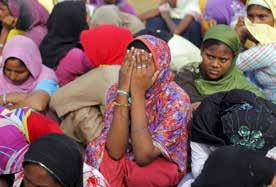

After initially deflecting blame for the crisis, on May 20, Myanmar’s foreign affairs ministry issued a statement carried by state-run media saying the government stood “ready to provide humanitarian assistance” and was “fully prepared to work with the international community” to help the “smuggled victims.”
As The Irrawaddy went to press, Indonesia and Malaysia expressed their willingness to offer temporary shelter and provide humanitarian assistance to the 7,000 “irregular migrants” trapped at sea. The apparent breakthrough came following a meeting of the Indonesian, Malaysian and Thai foreign ministers in Putrajaya, Malaysia on May 20.

Thailand was preparing to host a multinational summit in Bangkok on May 29 to address the “unprecedented increase” of boat people fleeing Myanmar and Bangladeshi shores.
Above, top: Maritime police patrol the waters around Langkawi island in Malaysia’s northern state of Kedah.

Above: A Rohingya woman, who arrived with others in Indonesia by boat, covers her face as she waits for breakfast inside a temporary compound in Lhoksukon, Aceh Province, on May 17.
A man who arrived on May 15 in Indonesia’s Aceh Province receives medical assistance. Nearly 800 “boat people” were brought ashore in Indonesia on the same day, but other vessels were sent back to sea despite a UN call to rescue thousands adrift with little or no supplies of food and water.

UHtun Myat Oo keeps a photo of Daw Aung San Suu Kyi on the dashboard of his San Francisco cab. Many of his passengers recognize the image. It’s the face of Myanmar’s struggle for democracy, made famous in the covers of Time, the front pages of Newsweek and the biopic by Luc Besson. Inevitably, questions follow: Why do you have her photo? Are you from Myanmar? Have you ever seen her?
In quick chats between lane changes and traffic jams, some taxi riders learn that their cabbie not only knew The Lady but once worked for her and went to jail for her. “They tend to be surprised, sometimes even shocked,” U Htun Myat Oo said.
Nicknamed Ko Pan Thee, U Htun Myat Oo was formerly part of the NLD Youth leadership—a fact that was more than enough to get him arrested under a military junta intent on stamping out political dissent.
After serving four years in jail from 1989 to 1993, U Htun Myat Oo was released under a general amnesty. In 2008, he arrived in the San Francisco Bay Area as a refugee. He has lived in the US long enough to qualify for citizenship. “But I’m not applying yet,” he said. “I’m holding out, waiting to see what happens in 2015.”
For U Htun Myat Oo and many like him, the general election due to take place in Myanmar later this year will be the best barometer to
measure the shifting political winds. Its outcome may help them make one of the toughest choices they confront: to go home or remain abroad.

US Census Bureau data for 2010 shows an estimated 100,000 Myanmar living in the US, though this is almost certainly an underestimation for today. Fort Wayne, Indiana, is home to one of the largest overseas Myanmar communities. Other communities have sprung up around immigrant-friendly places like California and New York.
Former political prisoners and dissidents like U Htun Myat Oo began arriving in larger numbers after the 1988 uprising and subsequent crackdown. Many of them remained politically active overseas. While learning English in community colleges and eking out livings in entry-level jobs, they continued to organize and hold political rallies for their homeland.
In late 2007, when news broke of the authorities’ use of force against the Saffron Revolution monks, Bay Area-based activists staged a sidewalk protest in front of the Chinese consulate in San Francisco to pressure the Chinese government to rethink its policy towards its neighbor. In the following year, they held fundraisers in local monasteries to help the victims of Cyclone Nargis. Every year on June 19 they lit candles on a cake to wish The Lady “Happy Birthday!”
“Going home” was something they talked about, but didn’t think possible. For many, the thought of return meant facing the prospect of arrest. Rightly or wrongly, many dissidents assumed they were on the government blacklist.
In August 2012, President U Thein Sein’s office released the names of more than 2,000 individuals taken off a blacklist believed to number around 6,000, a gesture signaling his administration’s commitment to reform. The status of the remaining blacklisted persons is still unclear.
One month after the president’s announcement, former student leader U Moe Thee Zun landed at Yangon’s Mingaladon airport to a cheering crowd. His return from New York was a good test case.
In 2009, when the then-prime minister U Thein Sein came to New York to attend the UN General Assembly, U Moe Thee Zun was among a small but vocal crowd of overseas activists who staged a protest across the street from the hotel that housed the Myanmar officials. When the delegation exited the hotel, U Moe Thee Zun threw a shoe at the motorcade.
If U Moe Thee Zun was permitted to return, the path seemed clear for those associated with even lesser offences.
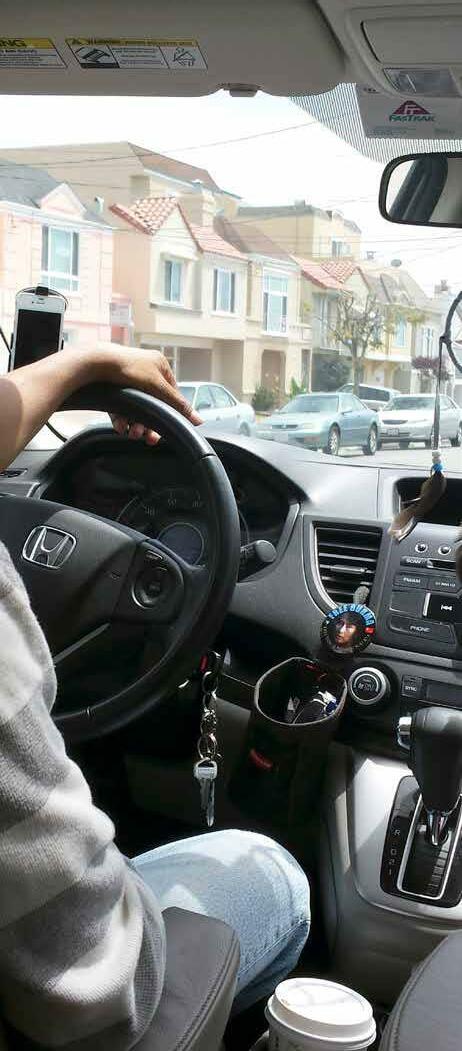
U Ko Ko Lay and U Moe Thee Zun—both of whom were once part of the All Burma Students’ Democratic Front—joined eight others for a 2012 trip dubbed “Peace Mission to the Motherland.”
“We wanted to test the waters, to see if we could trust them,” U Ko Ko Lay recalled. “Would they arrest us? Would they do something to us? Whatever they might do, we were ready.”
Despite their trepidation, the delegation was invited to meet with representatives of various ministries and its members were treated with courtesy and respect. Emboldened, they returned in 2013 to attend the silver jubilee of the 1988 pro-democracy uprising. It also proved a successful trip but still, U Ko Ko Lay found it difficult to trust the incumbent government. He thinks the feeling is mutual.
“These people were once part of the leadership of a military regime,” he reasoned. “I don’t think they trust us either. How could they? We took up arms against them. But the thing is, if we want democracy, we have to sit down and have discussions. We can’t keep fighting each other. We have to start building trust.”
Dr. Salai Tun Than, formerly professor and dean of Yezin Agricultural University, made headlines when he was arrested in 2001 for staging a solo protest in front of Yangon City Hall. He was sentenced to seven years imprisonment. He had previously studied in the US in Georgia, Wisconsin, and Florida universities as a state scholar, and calls for his release reverberated overseas. In May 2003, the government released him, citing “health and humanitarian concerns.”
Dr. Salai Tun Than traveled to San Francisco to visit his children, but ended up staying indefinitely. Eventually he applied for US citizenship, in order to be able to sponsor his wife to join him. “I never really intended to live abroad,” he explained. “But six months later, when I tried to return, they refused to let me go back in.”
In June 2006, Dr. Salai Tun Than attempted to enter Myanmar, but was stopped before he could board his Thai Airways flight at Bangkok’s Don Mueang airport. Then, in 2014, he heard from several sources that he was no longer on the government’s blacklist. Last December, at his former students’ urging, he decided to try to attend the 90th anniversary of his alma mater, Yezin Agricultural University. This time, he wasn’t stopped, although the visit was not without incident.

“My former students came to visit me at the guesthouse where I was staying. Sometimes the whole class would come to pay homage. They posted photos on Facebook. I think it got too much attention and made the authorities uneasy,” he said. “Eventually, I was told I couldn’t stay at the guesthouse anymore.”
On the other hand, when he applied for a visa extension, it was granted. Dr. Salai Tun Than stayed in Myanmar from December until early April. “I think within the government, there
are reformists who want to change,” he remarked. “But generally speaking, many of them seem to have just changed costumes, like actors in a theater troupe. Their mindset remains the same.”
If the military regime hadn’t nullified the outcome of Myanmar’s 1990 general election, U Maung Maung Latt would have been a member of parliament. Born and raised in the town of Bilin in Mon State, U Maung Maung Latt represented his district for the NLD.
He sought and received political asylum in the US in 1999 and, once abroad, joined the Burmese American Democratic Alliance, a nonprofit advocacy group. Today, he is the organization’s vice president.
In June 2013, Burma’s Lower House Speaker U Shwe Mann paid a visit to the overseas Myanmar community in the Bay Area. U Maung Maung Latt was in attendance and the men shook hands. “I’ve been studying [Shwe Mann],” U Maung Maung Latt said. “I think he cares about the people. But I also think he remains loyal to the military.”
U Maung Maung Latt’s political inclinations remain strong. He listens to the BBC, RFA and VOA for the latest developments back home. In his free time, he reads up on the US Constitution and has a lot to say about how the US model could be applied to Myanmar. Ideally, he said, he would like to resume his political career in Bilin.
“But that wouldn’t be possible under current Union Election Commission rules,” he said. The rules state that one must have lived in the country for at least 10 consecutive years prior to the election in order to run for parliament.
U Maung Maung Latt has never applied for a visa. He suspects he risks arrest and might put his loved ones in the country in jeopardy by going back because of his political activism overseas.
If he is given the chance to return home, U Maung Maung Latt said he’d like to pay homage to his parents, whose funeral he wasn’t able to attend. “Maybe I can organize a donation ceremony in a monastery in their name,” he said. “And I’d also like to report to my constituents. They elected me. I owe it to them to let them know about the work I’ve been doing.”

Typical immigrants work to integrate themselves into the social fabric of their new home country and make the most of newfound socioeconomic opportunities. It’s different for political refugees and former dissidents. The possibility of one day
going home, and the duty they feel to do so, prevent many from fully resettling in the new land.
U Ko Ko Lay said, “I haven’t done anything in the US that would tie me down. I haven’t bought a home. I don’t have children. I’ve arranged my life so that I can pick up and go.”
His personal policy, he said, is to “work together [with the government] so long as they show signs of genuine reform.” But one factor he finds troubling is the current government’s reluctance to amend the 2008 Constitution, which bars Daw Aung San Suu Kyi from running as a presidential candidate and guarantees the military 25 percent representation in parliament.
“To me, that constitution is not democratic,” U Ko Ko Lay said. “If they change the constitution today, I’ll go back tomorrow.”
Dr. Salai Tun Than also charts a course between hope and hesitation. “If the same government is reelected, I don’t want to go back,” he said. “If there are signs that prove their mindset has changed, perhaps I might go back, but I haven’t seen such signs so far.”
For U Htun Myat Oo, the decision to return is no longer his alone to make. “My son said he likes living in the US so I can’t just drop everything and go back. I’d have to split my time between
the US and Myanmar,” he said.
“I didn’t leave my homeland by choice. I left fully thinking of going back one day. I’m ready to go. I think the new government should welcome back overseas dissidents like us, who have gained lots of experience. We have a lot to contribute to the country’s rebuilding.”
Some Bay Area couples have been surprised to learn that the man hired to shoot their wedding photos, U Ko Ko Lay, once belonged to a ragtag student army that fought against a brutal military regime.
Circumstances have forced these activists, aspiring MPs and civic leaders to become photographers, taxi drivers and deck builders. Their humble occupations seem a mismatch for the historic events they participated in and the roles they played. Many continue to harbor aspirations to go home, to help make history, or—at least—to witness it.
But they also see the present political landscape of Myanmar as fraught with risks and uncertainties, making it difficult for them to give up what they have as immigrants and start all over again.
“I know of at least one comrade who became homeless in the US,” U Ko Ko Lay said. “But even so, he wouldn’t go back. He’d rather live homeless in a free country than go back to live under an unjust system. Look at the way the police shot a protester in Letpadaung. Look at the way they used force to crush the student protest in Letpadan. These [incidents] should tell you what kind of government this is.”
The Myanmar Embassy in Washington D.C. was asked to provide clarification on its policy regarding overseas dissidents for this article, specifically on the proper procedures required to remove oneself from the blacklist. At press time, it had not yet responded.
Kenneth Wong is a MyanmarAmerican author and blogger who grew up in Yangon. He now lives in San Francisco, California. His essays, short stories, and poetry translations have appeared in Grain, AGNI, Eleven Eleven and San Francisco Chronicle magazines.
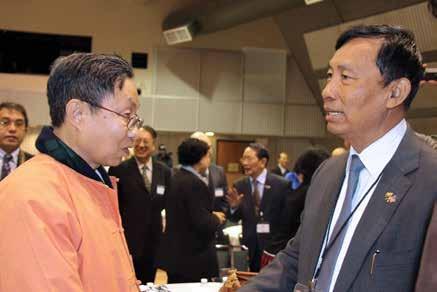
“I’ve arranged my life in the United States so that I can pick up and go.”
-U Ko Ko Lay
It’s a pity this book is only available in Norwegian. It would have been useful for a much broader audience to see what kind of naïveté prevails among Westerners trying to understand what has happened in Myanmar over the past few years.
According to the book’s author Kristoffer Rønneberg, a correspondent for the Norwegian daily Aftenposten, Norway was behind it all. The new “democratic” course charted by the Myanmar government, Mr. Rønneberg writes, is “in my view the most significant victory for Norway’s authorities in recent times.”
In all fairness, it should be said that “Veien til Mandalay: En reise fra Burma til Myanmar” (“The Road to Mandalay: A Journey from Burma to Myanmar”) is mainly a travel book and Mr. Rønneberg’s accounts of his visits to various parts of the country are lively and interesting. But when it comes to his attempts to understand Myanmar politics, he evidently ventures into unfamiliar territory.
He is not alone in believing that it was Western engagement with Myanmar’s generals that led them to embark on a process of change after conducting a completely fraudulent election in November 2010.
The Danish-Australian academic Morten Pedersen suggested in an interview in April with the Institute for Security and Development Policy—a Swedish think-tank not known for its astute analyses—that “re-engagement

by Western countries has helped support and deepen the reform process” but “Western re-engagement has not gone far enough… [and] there is an urgent need to demonstrate to the top generals in particular that the military too stands to benefit from reform.”
If anything, both Mr. Rønneberg’s and Mr. Pedersen’s views on Myanmar reflect what amounts to a blatantly neocolonial attitude. Words to the effect of: “We have to go and tell those funny little brown fellows how to run their country, and, because we are big and clever white guys, surely, they have to listen to us.”
It is, however, easy to imagine what the Myanmar generals’ reaction must have been when they received those Western proponents of engagement: “Those myauk pyu [white monkeys] are sort of amusing. But they are not very clever. So let’s use them.” Or words to that effect…
The bitter reality is that it’s the Myanmar generals who have successfully—and cleverly—managed to engage the West, not the other way round. The decision to re-approach the West was not taken because the generals were induced by some foreigners into a democratic awakening.
Internal, classified documents from the Myanmar military, compiled as early as 2004 and seen by this contributor, show that it was the country’s heavy dependence on China
that prompted them to realize the importance of opening up to the West. One such document even lists the names of Western academics and think-tankers who were in favor of “engagement.”
But the officers who compiled those documents were astute enough to understand that any rapprochement with the West would require certain political initiatives such as the release of political prisoners, more press freedom and freedom of expression, a proper constitution for the country
and a government that was not overtly military in nature. However, to give up power to a democratically elected government was never—and is still not—on the agenda.
It is also certain that “the China factor” was an important consideration when the US decided to change its policy from one of isolation, sanctions and boycotts to “engaging” with the quasi-civilian government of President U Thein Sein that assumed power in March 2011.


Myanmar’s only really close ally
during this period of isolation was China, and its dependence on Beijing was so great that the country was sometimes described as a Chinese client state. All that has now changed, and Myanmar may be the only example in Asia of how the US has managed to expand its influence at the expense of China’s.
Myanmar’s reform process has never been what it seemed—nor was the West’s response to it. The US, naturally, has policies and priorities other than their oft-repeated support
for democracy and human rights. The main issue that no one wants to talk about openly is, of course, the rising power and influence of China in the Asia-Pacific region—and here, there was a meeting of minds between America’s strategic thinkers and Myanmar’s generals.
Exuberant because of its success in this regard, the US has abandoned talk of “free and fair elections” and Washington is now calling for the polls to be “transparent, inclusive, and credible.” The civil war, which is
now more intense than at any time since the late 1980s, is conveniently brushed aside as a bump on the road to peace. Criticisms of ongoing humanrights abuses have become muted, if expressed at all. No one wants to hear any bad news. That’s not good for the “engagement policy.”
One of very few interesting revelations in Mr. Rønneberg’s book is to be found on page 206: Norway’s turnaround from being a vocal supporter of Myanmar’s prodemocracy movement to the main proponent of “engagement” was, according to him, “done in consultation with the US.”
That makes perfect sense. The US could not directly “engage” the then ruling junta because of acts passed by Congress, and the other main Western power, the European Union, was also prevented from cozying up to Myanmar’s generals because it had similar policies.
But Norway was in an ideal position to act as a cutout for Western interests in Myanmar. Norway is not a member of the EU, but it is a partner of the US in the Western defense alliance the North Atlantic Treaty Organization (NATO).
All historians are aware of the tale of the Trojan horse, a subterfuge the ancient Greeks used to enter the city of Troy in disguise. So have we now seen a Trojan reindeer, with non-EU, NATO member Norway acting as a cutout for US and perhaps also other Western strategic interests in Myanmar?
According to a human rights activist with long experience working on Myanmar issues: “By 2011 there had already been a marked shift in Norway’s policy, in favor of cooperation with the

government and away from the exiled opposition, including what should have been non-politicized humanitarian assistance. Thein Sein became the poster-boy of Norwegian self-interest and corporate greed and the betrayal of the democratic opposition.”
Indeed, Norway was awarded for its new policies with a lucrative contract for its telecom company, Telenor. The Norwegian ambassador to Bangkok, Katja Norgaard, who had been instrumental in implementing the new policies, went straight from the Norwegian Foreign Ministry to a high-placed job with Telenor.
Corporate greed went hand in hand with geostrategic considerations—“if we were not doing this, the Chinese would do it”—some Norwegian foreign ministry officials have said in private to pro-democracy activists. Perhaps Mr. Rønneberg is right in a sense: Myanmar has been a foreign-policy success for Norway. But not for turning Myanmar into a “democratic state,” which it is not.
At the same time, Norway’s new policies have also cost it a lot of goodwill among the population at large in Myanmar. It is no longer
seen as a supporter of democratic change. It is also evident that the neo-colonial, patronizing attitudes of not only Norway but also of deluded academics like Mr. Pedersen will have little or no influence on actual, political developments in Myanmar.
The military has its agenda. Their “political process” has not stalled, as some Western observers like to put it in light of recent repressive actions against student-led social movements in the country; it was never meant to be more than this. The generals have succeeded. They have the West on their side, have lessened their dependence on China and, most importantly, they remain in power.
If Myanmar is ever going to become a functioning democracy, it will be because of actions taken by the Myanmar people themselves, not because of the Norwegian diplomats and Western academics who are evidently overestimating their ability to influence the people in power in Myanmar. Those outsiders are mere pawns in a game of which they understand very little.
“Veien til Mandalay: En reise fra Burma til Myanmar” by Kristoffer Rønneberg is published by Dreyers Forlag, Oslo, Norway.
“Neo-colonial attitudes will have little or no influence.”
Drug-resistant malaria may be “jumping” from place to place, or “popping up” independently— either way the strategy to fight it in Myanmar is taking on a new urgency
By SAMANTHA MICHAELSDrug-resistant malaria appears to have taken hold in much of Myanmar, and scientists aren’t exactly sure how. It may have spread here from elsewhere, or it may have emerged independently, but in any case, the strategy to fight it seems set for a major change.
More than a decade ago, the deadliest type of malaria-causing parasite, Plasmodium falciparum, evolved in Cambodia, becoming resistant to the main anti-malaria drug, artemisinin.

For several years, resistant parasites have also been detected along the Myanmar-Thailand border, as well as in Bago Region, but earlier
this year, scientists revealed that the problem may be much greater than was previously realized.
In February, a study published in The Lancet Infectious Diseases journal showed that at 55 malaria treatment centers across the country, nearly 40 percent of parasite samples had genetic mutations linked to artemisinin resistance. In fact, these mutations were found in seven of the country’s 10 administrative regions, including in Homalin, Sagaing Region, only 15 miles from the Indian border.
And that’s a big deal. Myanmar— stretching from the Bay of Bengal and the Andaman Sea in the south to the Himalayan mountains in the north— offers the only known path for resistant parasites to make their way contiguously to the Indian subcontinent, and from there to Africa, where the disease already kills hundreds of thousands of children every year. This has happened in the past with other anti-malarial drugs that were once powerful but are now ineffective, resulting in the loss of millions of lives.
“Clearly, Myanmar is an important part of the frontline in the battle to contain artemisinin resistance,” the scientists wrote in the study. But “the pace at which the geographical extent of artemisinin resistance is spreading is faster than the rate at which control and elimination measures are being developed and instituted, or new drugs being introduced.”
Translation: Current strategies for fighting the disease aren’t working, and, should artemisinin fail completely, there’s no other medicine ready to replace it.
Artemisinin-combination therapies are still 95 percent effective in Sagaing, according to Dr. Pascal Ringwald of the World Health Organization’s Global Malaria Program. But in the event that they begin to fail, the results could be catastrophic in Myanmar, whose health-care system is still in shambles after half a century of neglect during military rule. The country also faces Southeast Asia’s largest malaria burden, with more than 333,000 confirmed cases reported in 2013, down from 480,000 cases in 2012.
Scientists caution that more testing is needed to confirm whether drug resistance is present so close to India. The sample size from the study was
relatively small, and debate is ongoing over whether the genetic mutations discovered are directly linked to resistance, or are merely indirect indicators of possible resistance, according to Dr. Francois Nosten, a Thailand-based malaria expert who contributed to the study.
If history repeats itself and drug resistance winds up in Africa again, it’s unclear whether it will spread there from Southeast Asia or emerge independently.
Dr. Christopher Plowe, director of the Institute for Global Health at the University of Maryland, which has major programs in Myanmar, says a sort of “paternity testing” for malaria parasites allows scientists to determine whether they are related to parasites in other locations. In Southeast Asia, he says, it appears resistant parasites are sometimes spreading from one place to another, in a process known as “jumping.” But in other cases, he says, they’re emerging independently, in a process known as “popping.”
“There are jumps between Cambodia and Vietnam, and in the published literature only pops so far
in Myanmar,” he says, adding that jumps have also been seen across the border between western Thailand and southeastern Myanmar. “The fact that both are happening is indeed the worst possible scenario.”
“It may be just a matter of time until artemisinin resistance takes hold in Africa, whether it is by popping or jumping… Great progress is being made in some African countries, less in others, but there is a nightmare scenario around the corner if we lose artemisinins: huge resurgences everywhere with no effective drugs to offer for treatment, and millions of deaths, as we had in the 1980s and 1990s.”
Earlier this year, scientists said they had detected malaria parasites in Kenya with mutations linked to resistance, and those mutations were different from the mutations found on parasites in Cambodia.
If resistance is popping up independently, Dr. Plowe says, it makes no sense to put up a firewall to block it, as countries in Southeast Asia have been trying to do for years. “A strategy of containment—the so-called firewall—is not likely to work, and we need to move fast to eliminate malaria” from the Greater Mekong Subregion and Africa, he says.
In 2011, the World Health Organization (WHO) called for a containment strategy to fight malaria globally, and two years later it launched an emergency initiative to contain drug resistance in the Greater Mekong Subregion—by distributing bednets, spraying insecticide and treating anyone who tested

“If resistance is popping up independently, it makes no sense to put up a firewall to block it.”PHOTO: REUTERS
positive for the disease. Heavyweight donors like the Bill & Melinda Gates Foundation and the Global Fund to Fight AIDS, Tuberculosis and Malaria were eager to help; the latter put down US$100 million over three years to fight malaria in the region. The WHO estimated at the time that $350 million more would be needed for Southeast Asia’s containment effort through 2015.
Francois Nosten, the Thailandbased malaria expert, isn’t convinced that drug-resistant malaria has only emerged independently in Myanmar, as Dr. Plowe suggests.
“The jury is still out,” Dr. Nosten says. But he’s sure that containment is not working well enough, and that it’s time for a strategy change. “We need to eliminate as much malaria as we can,” he says.
Others agree. In mid-May, the WHO was preparing to ask member states in the Greater Mekong Subregion to adopt a strategy of complete
elimination—taking steps to prevent any new cases of malaria from arising.

With the new strategy, health workers would continue to distribute bed nets, spray insecticide and treat people with the disease, but they could also go a step further: In some cases, they could give anti-malarial medicine to entire villages in malaria hotspots, including to people who don’t show any symptoms or feel sick.
This technique, known as mass drug administration, is set to be included in the elimination strategy, according to Izaskun Gaviria, the Myanmar portfolio manager at the Global Fund, which launched a pilot project for mass drug administration in Southeast Asia last year, including in Myanmar.
“No adverse effects have been documented so far, none whatsoever, which is quite encouraging,” she said. “Initial data indicates that the pilot project has been successful.”
Southeast Asian governments have already set a goal to eliminate malaria from the region over the next 15 years, Ms. Gaviria added. “Of course, some
countries can do it faster than others— Myanmar being for obvious reasons the last one—but we are hoping that by 2030 all the countries will have eliminated malaria,” she said.
But developments in Cambodia could point to new problems. There, parasites are starting to show resistance to piperaquine, a partner drug that’s used in combination with artemisinin.
“It is extremely concerning,” Ms. Gaviria said, noting that piperaquine resistance has not yet been detected in other countries. “Artemisinin makes you feel good within a very short period of time, but it does not kill all the parasite flow—it is the partner drug that does that—so if we lose the partner drug, we will be in big trouble.”
A British pharmaceutical company is also developing what could be the world’s first malaria vaccine, but it has only protected about one-third of children vaccinated during testing, and the research and licensing for it are focused on Sub-Saharan Africa. “So its use in Asia, while possible, is less likely in the near term,” Ms. Gaviria said.

Sitting at his home in Taunggyi, 100-year-old U Khan is still proud of what he did for Gen. Aung San, the father of Myanmar’s independence, on Feb. 12, 1947.


Nearly 70 years ago, U Khan drove Bogyoke (General) Aung San along a narrow, steep and snaking road that stretched 62 miles from Taunggyi to Panglong, where the national hero and ethnic leaders from Shan, Kachin and Chin states signed the historic Panglong Agreement as part of efforts to speed up Myanmar’s return to independence from British colonial rule.
Unsurprisingly, none of the leaders who signed that agreement are alive today. Gen. Aung San was the first of them to die, assassinated on July 19, 1947, just six months before the country gained its independence.
Born in 1915, the same year as Gen. Aung San, U Khan remains in good enough health that he can still be seen driving occasionally in his hometown of Taunggyi, where he was born to a migrant Muslim father and a Shan mother. U Khan still considers himself a devout Muslim.
“I drove him [Aung San] to Panglong on that day,” he told me, pointing to a photo of the revered general receiving a bouquet from a young local woman in Taunggyi, with U Khan sitting behind the steering wheel of a Jeep just before setting off for Panglong.
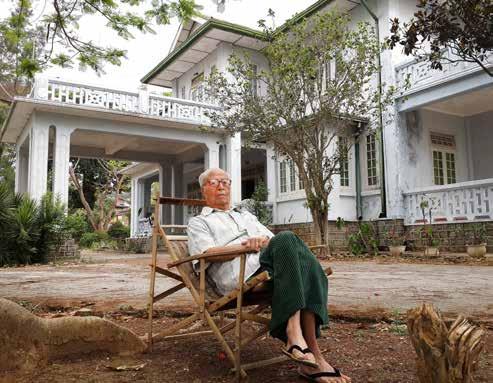
When they arrived at Panglong but before signing the agreement, U Khan recalled Gen. Aung San telling the gathered ethnic leaders, “You can separate your states from Myanmar after 10 years if you are not satisfied with [this agreement].”
U Khan said: “Ethnic leaders, including the Saopha of Yawngwhe [who would become Myanmar’s first president after independence in 1948], responded to Bogyoke Aung San by saying, ‘Let’s not talk of secession at the moment; we are just about to sign for a union.’”
Feb. 12 has since been recognized annually as Union Day and the historic Panglong Agreement remains a rallying point for Myanmar’s ethnic minorities, with its guarantee of full autonomy for ethnic regions never realized and still sought to this day.
U Khan and Gen. Aung San had become acquainted thanks to their common interest in politics and their country’s struggle for independence.
“Bogyoke Aung San was involved in the nationwide independence struggle, while we were involved in political activities here in our Shan State,” U Khan said. “I worked with U Tin E for the Shan State People’s Freedom League.”
The late U Tin E, who was one year U Khan’s junior, was one of a handful of prominent Shan leaders who managed to convince many Shan to support Gen. Aung San’s Panglong plan to expedite independence from Britain, which was seeking a show of unity before agreeing to relinquish the whole of the country.
In 1952, four years after the country had rid itself of the yoke of colonialism, U Khan was elected as the first mayor of Taunggyi, the capital of Shan State. Four years later, he was re-elected to a second term and was also appointed
chairman of the Taunggyi Municipal Committee.
As mayor in the 1950s, U Khan received domestic and foreign dignitaries during his time in office. Photos on the walls of his home capture the centenarian with Myanmar’s President U Ba Oo and visiting Chinese President Liu Shaoqi, both of whom paid visits to Taunggyi. The premiers U Kyaw Nyein and U Ba Swe were also among his acquaintances. While serving as mayor, he was also a successful businessman, running movie theaters and a construction company that operated in Taunggyi and other towns in southern Shan State.
However, doomsday came for him on March 2, 1962, when the late dictator Gen. Ne Win staged a coup, ousting from power the civilian government led by Prime Minister U Nu. Indeed, that fateful Friday was a dark turning point not just for U Khan, but for the entire country.
In the wee hours of March 2, Gen. Ne Win’s troops began surrounding the homes of cabinet members as well as ethnic leaders, most of whom were
Shan princes, known as saophas, in Yangon and across Shan State. The soldiers arrested the entire cabinet, including the then incumbent President Mahn Win Maung (an ethnic Karen), U Nu and the rest of the government ministers. In Shan State, almost all of the 25 Shan saophas who were members of the regional Nationalities Parliament and another 25 members of the People’s Parliament were arrested along with other politicians.
Myanmar’s former first president and the incumbent chairman of the chamber of nationalities, the saopha of Yaunghwe Sao Shwe Thaike, was among the purged Shan princes, having also been apprehended at his residence in Yangon. During the arrest, one of his teenage sons was killed. Gen. Ne Win’s regime said he died as guards at the saopha’s residence exchanged fire with the soldiers attempting to arrest Sao Shwe Thaike. It was reportedly the only casualty of an otherwise bloodless coup.
Gen. Ne Win’s takeover destroyed the union spirit that had been forged by Gen. Aung San and the ethnic leaders at Panglong, with the Burman-dominated
military junta entrenching distrust between the country’s ethnic majority and its many ethnic minorities. Without question, it dealt a devastating blow to hopes of ending Myanmar’s civil war, which by that time had entered into its second decade.
U Khan was also among those arrested.
“I was sent to Insein’s annex jail,” U Khan told me, referring to a compound within Insein Prison, a penitentiary in Yangon that has housed thousands of political prisoners since the 1962 coup.
Sao Shwe Thaike and other politicians were also kept at Insein, where U Khan said he still can’t forget one morning in November 1962.
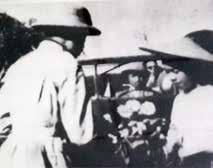
“Around 7 am, Sao Shwe Thaike shouted to us, ‘How are you guys?’, while he was taking a walk to work out in the prison compound,” U Khan recalled. “At around 11:00 am, he died. We had no idea why.”
“He was poisoned,” one of my friends, seated next to us, interrupted. U Khan responded: “I know, I know. Not good to talk about it.”
After having spent six years in the country’s biggest prison, U Khan was finally released without charge. Though he was no longer behind bars, he wasn’t truly free.
Authorities did not allow U Khan to return to Taunggyi, instead forcing him to remain in Yangon where they could better keep an eye on his activities. He was under this “city arrest” for four more years.
“They [authorities] just told me to come with them for a while,” U Khan recalled of the moment in 1962 when he was taken from his home. “That ‘for a while’ meant 10 years in detention.”
Some businesses belonging to U Khan were confiscated by Gen. Ne Win’s Revolutionary Council, including two cinemas, as the government nationalized commerce across the country in the name of the “Burmese Way to Socialism.”
“At one of those locations, you can see Innwa Bank today,” he said, perhaps adding insult to injury for the man, given that Innwa Bank was
founded by the Myanmar Economic Corporation, a conglomerate owned by the military.
U Khan has never received any form of compensation for the businesses he lost. After his release, he went back into the construction industry in Taunggyi, but chose to remain outside the civic arena.
“I didn’t return to politics,” he said.
And though his past woes are attributable to a dictatorship that has ostensibly ceded power, Gen. Ne Win and his military successors still cast a shadow.
“I shouldn’t have talked a lot to you,” he said as our conversation neared its end. “If I talk a lot, I am afraid that I might be ‘invited’ to prison again.”
U Khan’s son jumped into our conversation to say that his father no longer dared to say anything critical.
One of the reasons, his son explained, is that U Khan was again detained for a few days when the nationwide pro-democracy uprising rocked the country in 1988, despite his having steered clear of politics for decades.
More than a half century after his first arrest, I can feel that the 100-year-old still lives in fear.
Though he is no longer willing to engage in politics, it hasn’t dampened his interest in the subject, nor caused him to shy away from visible affiliations with the country’s opposition.
One photo hanging on the chimney in his living room shows U Khan with U Tin Oo, a former commander in chief and founding member of the National League for Democracy (NLD), Myanmar’s largest opposition party led by Daw Aung San Suu Kyi.
“He [U Tin Oo] visited my house in recent months. Daw Suu is very good and smart. I am not a politician but I am interested in politics,” U Khan said. “I want to see Myanmar as a good country.”
Whatever the past, U Khan said life at his ripe old age is peaceful and filled with contentment.
He still goes to the office most days after morning prayers, though he no longer handles the business responsibilities and simply enjoys meeting up with his friends to shoot the breeze.
“Sometimes I still drive, but I don’t have a driver’s license anymore,” U Khan said. The licensing department, his son said, stopped issuing him a driver’s license after deeming him too old to get behind the wheel.
“But he is quite impatient if I drive,” said his son with a laugh, leading one to wonder what kind of harrowing road trip the apparent lead-foot may have embarked with Bogyoke so many years ago.
“At around 7 am, Sao Shwe Thaike shouted ‘How are you guys?’, while he was taking a walk in the prison jail. At around 11 am, he died. We had no idea why.”






A “lost world” is slowly revealing its treasures — and vulnerability
By SANDY BARRON / YANGONBailey Island is located at the remote outer northern end of the Myeik archipelago, and on December 16 last year it looked in good shape.

At around 2.30 pm a boat carrying marine specialist U Zau Lunn, photographer Lawrence Davis and scientists approached the island’s picturesque southeast bay on the seventh day of a trip investigating the archipelago’s northern coral reefs.
Mr. Davis dived into the water and down towards the long stretch of coral he had first visited about eight months earlier.
Floating about in a glorious abundance of color, he worked fast to record a kaleidoscopic variety of slug-like nudibranches, staghorn coral, fish and an array of other small marine life. A juvenile emperor fish swam into view, along with angel and parrot fish.

After about an hour of recording the reef the team from conservation organization Flora and Fauna International (FFI), the government and others moved on to the next dive site, wasting no time on a trip that is part of new efforts to understand the life contained below and above water within the 14,000 square miles of the archipelago.
Researchers are excited at the start of efforts to rediscover a formerly “lost” maze of some 800 islands whose distance for centuries from centers of power kept their natural life largely intact.
Little solid information exists still about the mammal, reptile and birdlife that survives on the 7,767 square miles of island territory where deer, pangolin, squirrels, bats, langurs, boars, gibbons and macaques have been reported.
In the sea, dugongs, turtles, otters, dolphins, whales and sharks are among the known residents.
Some 1,056 square miles of coral provides fish and other marine
life with breeding grounds and protection.
After recent expeditions by FFI and others, it’s known now that the area contains some 300 species of coral, including two branching corals, Acropora roseni and Acropora rudis, that are on the IUCN red list of endangered species.
Though not as great a variety as that found in global coral hotspots in Indonesia, it’s still a high tally for surveyed reef territory of which up to 80 percent has been graded as “excellent.”
Scientists’ interest has also been piqued by coral reefs able to support rich fish life even in murky water off inshore islands.
“This finding excited the team and these reefs were among the most species-rich we visited,” FFI marine coordinator U Zau Lunn said after
the group’s first expedition to the area earlier last year.
And there is a theory that floating coral larvae from unusually resilient coral from the Myeik area have helped seed coral revivals further south in Thailand.

Early this year, Robert Howard of FFI in Yangon was reviewing data
from the December 2014 trip when he made an unwelcome discovery.
Colleagues from the International Union for Conservation of Nature (IUCN) had visited southeast bay on Bailey Island a few weeks after the FFI team had departed.

The coral “wasn’t there anymore,” Mr. Howard was told. “All that habitat was just… gone.”
It takes about 30 years to grow
The archipelago is spread over some 14,000 square miles of ocean.complex coral that illegal blast fishing can destroy in 30 minutes.

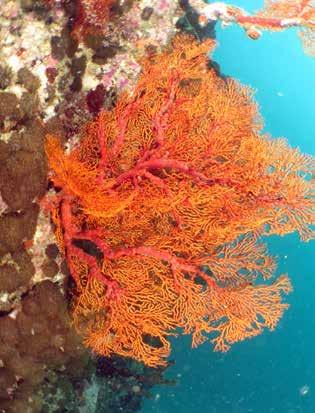
“Destructive fishing practices are still rampant. It’s very worrying,” said the IUCN’s Southeast Asia deputy Petch Manopawitr.
Its teams had heard the sound of blast fishing in the distance on recent trips, he said. They also recorded the bombed remains of previously healthy reefs.
Light-luring night fishing in the area was catching too many species indiscriminately, and too many juvenile fish, he said. And even spear fishing is being overdone.
“We came across a boat load of mature parrotfish caught by four men in just over two days,” Mr. Petch said. “It’s not eaten locally. It’s all for export, mainly to China, and some to Thailand.”
As algae-eaters, parrot fish are vitally important to the health of coral systems.

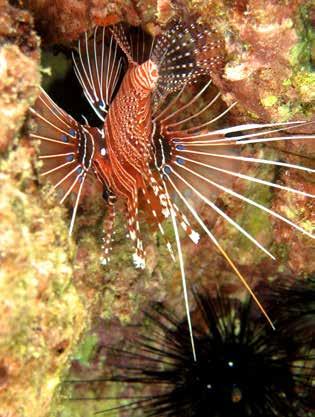
Overfishing mainly by bottom trawling is now seen as an issue for all the ocean off Myanmar’s 1,740 miles of coastline. Last month the government announced a threemonth moratorium on ocean fishing from June 1, due to concerns over diminishing fish catches and exports since 2012. Since last year, foreign boats are no longer permitted to fish in Myanmar waters.
The archipelago’s old reputation as a wild and pristine place home only to Salon seafarers and as a onetime pirate stronghold is out of date.
For centuries the region’s peripheral location and long monsoons helped it evade the administrative orbit of the Myanmar, Siamese, or British rulers who claimed suzerainty over it, but that has changed in recent decades.
Increasing numbers of Bamar as well as some Kayin and others have made their home on the islands where they work mainly in fishing and small agriculture. Fruit and rubber are grown on some of the larger islands.
Above and below: Some of the colorful coral and marine life in the Myeik archipelago’s northern coral reefs.

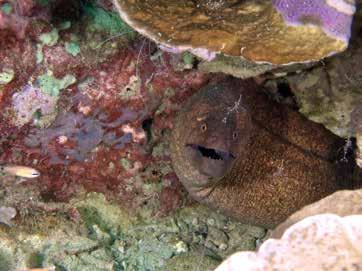
Intermarriage and pressure to settle is altering the traditional lifestyle of the Salon whose roaming territory already shared with fishers, settlers and the Myanmar navy is in the sights of yet more newcomers, including developers, tourists, government departments and international organizations.
The government’s decision to put forward the region for consideration on UNESCO’s list of world heritage sites suggests an interest in preserving the integrity of the archipelago.
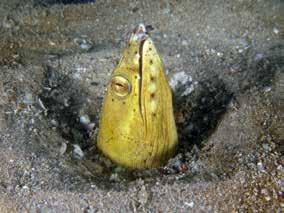


But legal and regulatory protections still apply chiefly on paper, even for the national park designated on Lampi Island since 1996.

‘‘We came across a boat load of parrot fish that had been caught by four men in just two days.”Right and below: A small sample of the dazzling array of marine life in the coral reefs of the northern Myeik archipelago. PHOTO: LAWRENCE DAVIS/FFI PHOTO: LAWRENCE DAVIS/FFI PHOTO: LAWRENCE DAVIS/FFI PHOTO: LAWRENCE DAVIS/FFI
Meanwhile activities and pressures on the ground are speeding up before protections are in place.
It was revealed in May that scores of developers are waiting for permission from the Myanmar Investment Commission to build tourist resorts. A Singapore-based group is seeking to transform an entire so-called “Salon Island” to the south into a resort and casino.
While weak regulatory safeguards clearly pose risks for islands already said to have lost most of their valuable trees to illegal logging, and to be suffering pressure on shoreline mangrove and sea grass habitats, efforts are increasing to safeguard the underwater environment.
Conservationists hope to see a network of mini Marine Protected Areas (MPA) throughout the archipelago.


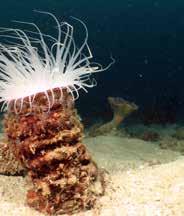


This would require government and scientific oversight as well as participation and buy-in from members of the Myanmar Fisheries Federation and other interests. The plan would also need to win over local communities traditionally more inclined to avoid rather than embrace outside interference.

Petch Manopawitr suggested that all key biodiversity and uninhabited areas could be set up as MPAs. On islands inhabited by people, community management systems would be drawn up..
A properly set up system connected to a transboundary conservation area with Thailand would “greatly boost the archipelago’s chances of a World Heritage Site listing,” he said.
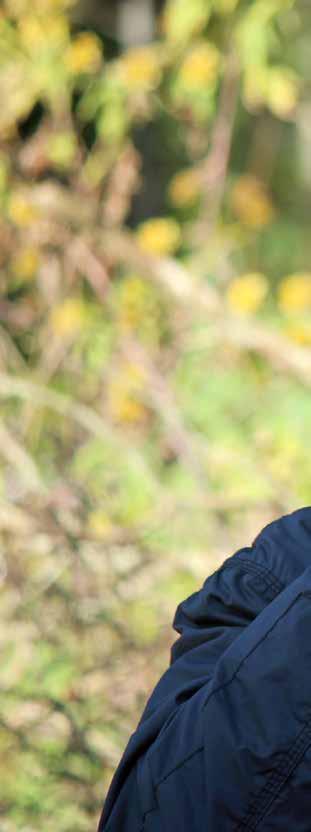




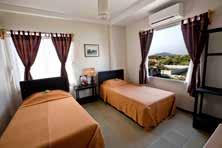



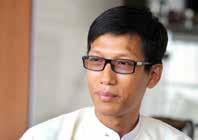



Standing outside his home an hour’s drive from the northern town of Pyin Oo Lwin, U Ye Myint looks out on a view of rolling hills and imagines a greener, more prosperous future.
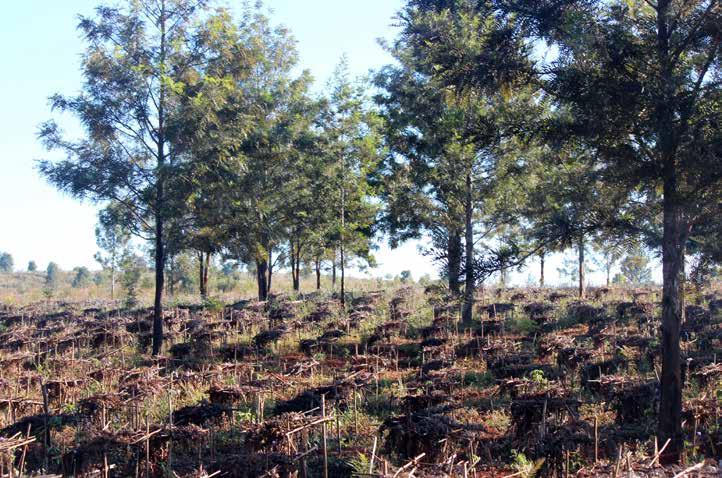
“This region could be the coffee capital of Myanmar,” said the fiftysomething who is banding together with other farmers in the north to try to take Myanmar’s coffee profile to the next level.
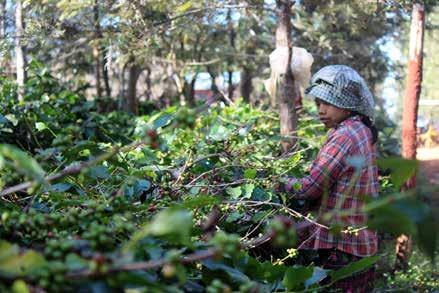
Myanmar has grown coffee since the British introduced Arabica plants to Shan State. Today coffee plants are grown in numerous locations throughout the country, from Kachin State in the north to Mon State in the south, but on a relatively small scale and largely at the lower end of the business.
“It’s a sad reality that we have fine raw materials here, but we’re not producing many high-quality products,” said U Ye Myint.
Much of the country’s coffee output consists of lower-grade Robusta beans for instant coffee and export. Better quality Arabica beans grown in Shan State and other locations are mainly sold to traders at the Myanmar-China border and elsewhere for low prices.
In order to try and kick start a new era, U Ye Myint and other coffee farmers in Pyin Oo Lwin and Moe Gote in Mandalay Region, and Naung Cho and Ywar Ngan in Shan State, formed the Myanmar Coffee Association (MCA) last year.
Its members want to increase home-grown processing of beans to
create higher-grade finished products, including specialty coffees.
They also hope that more coffee associations will spring up throughout the country, including in locations such as Kayin, Kachin and Kayah states, to help boost the industry, raise livelihoods and encourage competition.
This year, however, the MCA is trying out taking joint action among its members to protect prices. In 2014, the price for beans fell to 300 kyat per 0.65 kilogram, which did not cover some farmers’ costs. Some didn’t even bother to collect their harvest. So in 2015 the association members have
agreed to set a standard price of 500700 kyats per 0.65 kilo for their beans.
Moving forward in the emerging sector still involves a lot of trial and error.
U Ye Myint was a farming novice when he began growing coffee using organic methods 16 years ago on 200 acres of land near Pyin Oo Lwin.
He has seen a lot of setbacks over the years, from his plants failing to thrive, to fires on the plantation. With some help from the state agricultural arm, he has conducted continuous testing of growing methods and plants.

The fact that the venture has often
made losses hasn’t dimmed his passion for the business.
“I just have to keep trying,” he said, while walking amid some of his planted saplings that are tended to by migrant workers who earn between 2,500 and 5,000 kyat a day, depending on their qualifications.
MCA secretary U Min Hlaing, who has a 40-acre coffee farm, estimates that the Pyin Oo Lwin area has around 5,000 acres under coffee, including some in tiny 5-acre plots owned by locals who also grow produce like strawberries and flowers.
That’s still far short of the portion envisaged by the former military government when in 2002 it launched a plan to plant around two hundred thousand acres of coffee throughout the country, mainly in highland areas. Large swathes of land were seized or reallocated for the purpose, much of it still unused.
Last year U Tin Maung, a union lawmaker from a constituency in Mandalay, said in parliament that about 18,000 acres are under coffee nationwide. Around Pyin Oo Lwin, much land earmarked for coffee remains idle in the hands of former military figures, a local said on condition of anonymity.

Deforestation in the area, including for the production of quick lime, is also taking a toll as the climate becomes hotter and drier.
Coffee growers say their businesses can help the environment, as they plant larger trees to provide shade for the coffee shrubs.
For now, the main challenge is to improve the product and find new markets. U Ye Myint is completing a new processing plant for that purpose.
His fellow MCA member Ko Soe Hlaing manages the 100-acre Myanmar Coffee Plantation company, which began its own processing in 2010.
After its products garnered interest at a food trade fair in South Korea, it is increasing yearly production of 13 tons by some 50 percent.
“Japanese and Korean dealers bought our products last year and liked them, so this year we aim to produce 20 tons,” said Ko Soe Hlaing.
Almost a decade after Myanmar’s 2003 banking crisis, the government introduced debit cards overseen by the Myanmar Payment Union (MPU) in 2012, the country’s sole domestic card-based payment system. Despite a still-weak local banking sector, debit cards are rapidly gaining in popularity, although technical errors and poor infrastructure continue to hamper users’ experiences. The Irrawaddy’s Kyaw Hsu Mon spoke with Ko Zaw Lin Htut, Chief Executive Officer of the MPU, on his vision for a “cashless society.”
When was Myanmar Payment Union (MPU) first formed and who led the process?
MPU was founded in 2011, at the start of the civilian government’s term. It was established under the Central Bank of Myanmar. There was a payment system development committee before the MPU was formed, so the government reorganized the committee and allowed us to form the payment union in 2011. The chairman was the Central Bank of Myanmar’s chair at that time. The member banks became the vice chairs and filled the other positions. In late-2011, member banks contributed 200 million kyat to start the process after setting up the union. There were [originally] 15 banks including three state-owned banks. In October 2012, we started operating the MPU debit cards and distributing them to users. At that time there were only four ATM machines, each from
member banks, set up for card users around the country. In 2015, there are now 21 member banks and more than 1,300 ATM machines around the country are ready to use.
When can we expect credit cards to be launched in Myanmar?
Actually we had launched credit cards prior to the 2003 banking crisis, but it was stopped. A card-based system was re-introduced in Myanmar in 2012. We’re proposing to the Central Bank to allow credit cards on behalf of members’ banks here. We expect that the Central Bank will allow this very soon as they know we need a better financial system. That’s why we’re encouraging member banks to get ready to issue credit cards when the Central Bank gives the green light.
Which foreign financial groups are working with MPU today?
UnionPay International (UPI) [a subsidiary of China UnionPay] and Japan Credit Bureau (JCB) are both working with us. We launched their cards for use here in 2013. Now we’re working together to launch core brand cards like JCB-MPU and UPI-MPU soon. When we’re permitted by the Central Bank, the members’ banks will produce cards soon. MPU cards can also be used in foreign countries within our member banks’ network.
So Myanmar card holders will not need to bring cash and, like other citizens, can use cards… They [UPI and JCB] have been working in the banking industry for a long time. We can study the latest technology and how to make the process run smoothly [by learning] from them.

What are MPU’s plans to upgrade the system? Some card users have recently complained that they can’t withdraw money from ATMs due to technical errors.
Some said their cards have been taken by the machines after they keyed in the wrong [pin] number three times when withdrawing money. This just means that we’re protecting the card holders. If the real owners are using their own cards, they can’t be entering

the wrong [pin] number three times. It is international practice that if a pin code is [entered] wrong three times, the machine will take the card, believing it is fraud. That’s why we’re always warning users to set easy pin numbers that can’t be forgotten. Communications [infrastructure] was terrible in 2012 compared with today. Now the internet connection is getting better. But we can’t say it is one hundred percent OK. We know we faced difficulties when starting the cards, we know card holders are facing problems, anyway, we thank them and the media too. But to be successful in this process, MPU can’t do it alone; we will have to work together with the government, stakeholders and users.
What is your plan to protect users against fraud, including those
who have their accounts accessed by third parties from ATMs?
This kind of fraud is happening everywhere, not only here. Card fraud happens all over the world, it can be counted in billions of dollars every single year. That’s why card companies use the latest technology to protect card holders from fraud. We’re also going down this path. Because we’re coming to this business late and learning lessons from other countries, we can be protected by the latest technology here.
How many MPU card users are there in the country?

About one million people are now using MPU cards in Myanmar. At the moment, we can only issue debit cards.
If we could issue credit cards here also, we would expect an increase of three to five million users each year [to a total of] 30 million card users.
What do you think will be the impact when the Central Bank allows banks to issue credit cards, since most Myanmar people have not owned a credit card before?

The advantage of credit is that when you do not receive your salary and you need to buy something urgently, you can use your credit card. But if you can’t control your credit and use it excessively, it will create problems. We will have to find a balance. But it is the best way to transition to a cashless society in the future. I think the government is taking a long time before allowing credit cards because it is considering different views.
Are you facing any delays or difficulties in working with the Central Bank?
I agree some processes are being delayed by the Central Bank, though they are an independent body now. I think they are also facing a human resources problem too. If they can take quick action and processes, it will be better for the speedy development of the market in our society.
What is the latest on the MPU transforming into a public company?
Recently, we’re now working with our local consultant company to finish our own policy. We will apply for company registration with the government within two months. We will attempt to start working within one year. After forming the public company, we will look to stand as a commercial organization. So we will look to profit too. Our payment system will be upgraded for people to use, at lower prices. We will later expand in many areas.
Were it not for its beautiful beaches, Kabyar Wa would be indistinguishable from any one of hundreds of Mon State’s farming villages. Home to about 300 households, most of the area’s inhabitants stake their livelihood on fishing, betel orchards and small-plot subsistence farming.
Despite being only 27 kilometers (17 miles) away from Ye, the journey into Kabyar Wa takes an hour by motorbike. Communications infrastructure is nonexistent and the area falls under the aegis of the Mon National Liberation Army.
Yet life is beginning to change in the village. Last year, after the Ministry of Border Affairs funded the replacement of the rickety wooden bridge into the Kabyar Wa with a new concrete structure, the site has become host to an increasing number of local travelers seeking a weekend’s rest and respite by the Andaman Sea.
Not long after the announcement, U Aung Moe, who lives by the beach, decided to capitalize on the village’s new profile by setting up a restaurant. There were barely any customers when he started five months ago, he told The Irrawaddy. In the time since, two new restaurants have opened up to compete for the small daily trickle of local tourist traffic.
The Mon State government designated the village’s 13-kilometer (8-mile) stretch of beach as a hotel and recreation zone in Sept. 2014.

Facilities will be developed under the management of local firm Aurum Co., primarily known for its mining operations, with the construction of an assortment of resorts, bungalows and midrange hotels.
The increasing profile of the Kabyar Wa beach has now jeopardized the government’s hope to realize its expansive hotel and resort plans by the planned 2017 completion date. News of the proposal has led to a speculative frenzy in beachfront land prices, with a 100-fold increase in value over the past year.
“It’s difficult to develop it now due to land issues,” said Nai Lawi Aung, the state electricity and industry minister. “The project hasn’t been developed yet because of land brokers manipulating prices.”
Before the government’s announcement, a beachfront plot, usually 40 by 60 meters, cost only US$100-200. Some of the plots were used as makeshift toilets by villagers and many others were neglected completely. After Aurum stalled on its land acquisition plans, the same plots are now selling for $1,000-$20,000, depending on their location and size, with prospective buyers coming from as far away as Yangon and Myawaddy.
Almost all land along the beach now has new owners, collectively hoping to sell the titles back to the company for a quick windfall.
Kabyar Wa’s development has been further stalled by bureaucratic hurdles. The company has so far acquired only
17 hectares (43 acres) of wild land around the village, with promises to provide tarmac roads, medical clinics, a market, a monastery and fire engines to the local community. Work cannot begin on many of these proposals until they are approved by the state Department of Lands, an arm of the Ministry of Agriculture and Irrigation. Nai Lawi Aung said that the state government did not have the authority to grant the company permission, and was limited to granting assistance in the company’s application to the department.
U Htay Thwin, Aurum’s managing director, told The Irrawaddy earlier this year that his firm expects to spend $12 million on infrastructure and preliminary hotel developments, before seeking partnerships with international
companies to build further resort facilities.


With the surge in land prices and construction delays, it is unclear whether the project’s budget will exceed its initial projections. Meanwhile, in
one of the few areas of Mon State to welcome a development proposal with open arms in recent years, villagers have become frustrated that the expected boom in tourist arrivals has yet to occur.
“[Aurum] are waiting for a hotel zone to develop,” said U Aung Yin Oo, an orchard owner in Kabyar Wa. “They said that a hotel project would start this year but it has yet to begin. Locals want them to start as soon as possible.”

Cross-border trade between Myanmar and Laos could benefit from the inauguration last month of the first bridge spanning the Mekong River between the two countries.
The wait for a new law to regulate the mining sector may extend beyond elections this year, a report from the Wall Street Journal suggested in May, amid concerns that the slow pace of legislative change is holding back potential investors in the extractive industry.

The report cited Ministry of Mines Director General Win Htein saying that lawmakers could not agree on how revenues would be shared from the vast mineral wealth thought to be sitting beneath Myanmar.
The new law has been in the works since 2012, but amid ongoing conflict in ethnic states, the issue of resource sharing is highly controversial.
“Analysts have warned foreign investors against hoping for any major legislative change before Myanmar’s upcoming general elections, scheduled for this November,” the Wall Street Journal report said.
Business groups have been lobbying hard to get the law passed, and it is thought the existing rules on mining may be a stumbling block for Western firms wanting to enter an industry currently dominated by opaque Chinese investments.
“Myanmar’s current mining law dates back to 1994,” the report said. “It includes no protections for foreign investors and shuts them out of important sectors such as coal and gold, forcing foreigners to partner with local companies if they are interested in these materials.”
In an analysis of Myanmar’s mining sector published late last year, lawyers Norton Rose Fulbright also highlighted the difficulties posed by a burdensome permits regime requiring companies to repeatedly seek authorization at different stages of a project.
“The lack of a new mining law is undoubtedly a contributing factor to the sector’s inability to attract significant foreign investment,” the analysis said, adding that problems around land acquisition were also a concern. —Simon Lewis
President U Thein Sein officially opened the bridge on May 9 with the unveiling of a stone plaque on the Myanmar side of the “MyanmarLao Friendship Bridge” in Tachilek township. The two governments hope that the new link will help development in the Golden Triangle region, an area historically dominated by smuggling and the opium trade. The Myanmar side of the bridge is in eastern Shan State, where a number of ethnic armed groups still control large swaths of territory.
State-run media cited Foreign Minister U Wunna Maung Lwin saying that the bridge will form part of the regional Northern Economic Corridor, which will link Kyaukphyu on the coast of Rakhine State with Haiphong in Vietnam and the South China Sea.
According to Chinese state news agency Xinhua, the bridge is almost 700 meters long, and cost US$26 million to build. The agency said the bridge can withstand vehicles weighing 75 tons.
—Simon LewisThai company SPCG Public is expected to set up solar power “mini grids” in Myanmar before the end of the year, according to a recent report.
Japanese news agency Nikkei reported an interview with the Bangkok-listed company’s CEO, Wandee Khunchornyakong, highlighting Myanmar as a growth market for SPCG. The report described the company as “Thailand’s largest solar power company,” adding that the firm has 36 solar farms generating a total of 260,000 kilowatts of power in Thailand.
“A mini grid capable of generating up to 1,000kw will supply electricity to plants and homes in Yangon, Mandalay and other cities in Myanmar,” Wandee was cited as saying.
The CEO estimated that the so-called mini grids would cost about US$2 million each to build, and said that funding would come from World Bank Group and Japanese electronics company Kyocera, according to Nikkei. —Simon Lewis
Indian company SLCM Ltd. has joined up with Cooperative Bank (CB Bank) to offer finance to Myanmar’s farmers, according to a report in the Mumbai-based Economic Times newspaper.
The report said that SLCM, a subsidiary of Sohan Lal Commodity Management, would allow Myanmar farmers to get credit using their produce as collateral.
“The step is aimed to provide agri-financing solutions to farmers, processors, traders, exporters and importers across Myanmar,” the report said, adding that CB Bank will allow farmers to pledge up to 60 percent of their crop in order to secure loans at an annual interest rate of 13 percent.

The commodities would be stored at SLCM warehouses in Myanmar, it said. SLCM also tied up with Yoma Bank earlier this year.
“This is the second tie-up that we have formalized in 2015 in Myanmar after the MoU with Yoma Bank earlier this year,” the Economic Times quoted SLCM chief executive officer Sandeep Sabharwal as saying.
“Our output has been very encouraging from the earlier association and the way in which we are
seeing a paradigm shift in Myanmar’s economy and policies, especially relating to agriculture and collateral financing, we are determined to further explore the region and fourfold our presence there.”
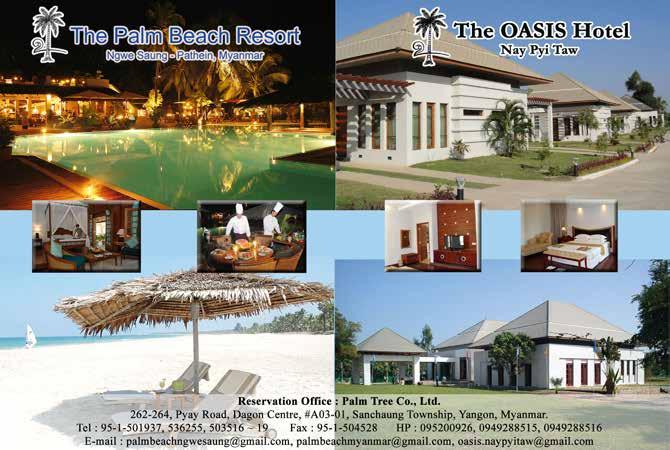
—Simon Lewis

A new memoir on the life of Daw Tinsa Maw-Naing offers unique insight into turbulent times
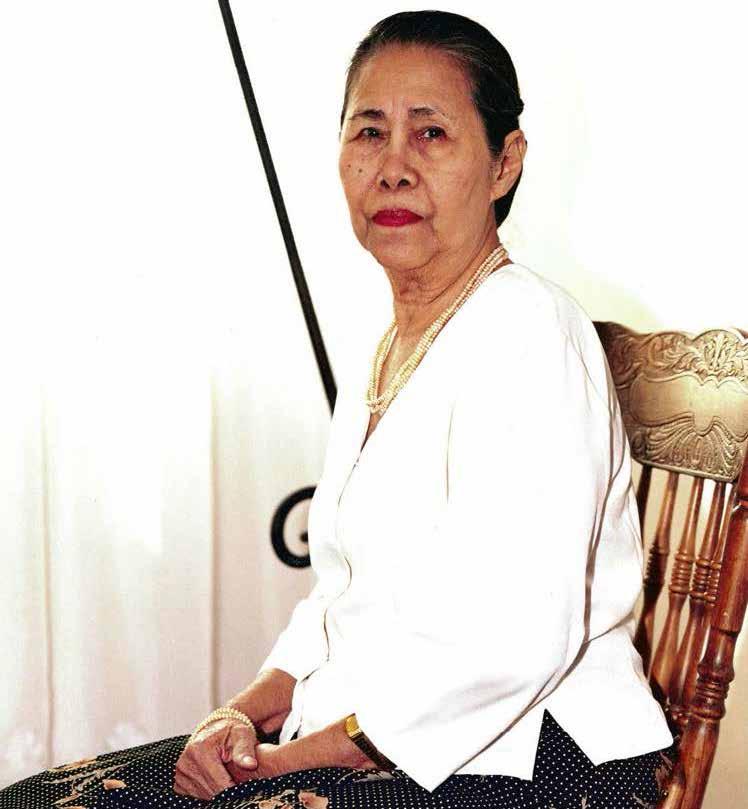 By HNIN WATHAN / YANGON
By HNIN WATHAN / YANGON

Books on Myanmar’s recent history invariably mention Dr. Ba Maw, the country’s prime minister and then Naingandaw Adipadi (Head of State) under British and Japanese rule respectively, and the “Thirty Comrades” who played a significant role in Myanmar’s fight for independence.
What makes the new book “A Burmese Heart” unique is that it is the personal account of Daw Tinsa Maw-Naing who was irrevocably connected to this historic and tumultuous period. Not only was she the daughter of Dr. Ba Maw, she was also the wife of one of the Thirty Comrades, Bo Yan Naing.

Daw Tinsa Maw-Naing had a relatively privileged upbringing during the British occupation, attending school at St. John’s convent alongside other students from among the “wealthiest families in the country, [who were] mostly Burmese but included a fair mix of Indian, Chinese and half-European girls.”

She lived through the seismic events of Myanmar’s history, from the trial of Saya San, the leader of an anti-British revolt, at which her father was a defense lawyer; to the anti-Indian race riots; the Japanese
occupation; the assassination of Gen. Aung San; and the rise of military strongman Gen. Ne Win.
History is usually recounted through the eyes of men—especially
when it comes to political events. But having interacted with people like post-independence prime minister U Nu, Gen. Aung San and student leaders at her home when
they came to see her father, Daw Tinsa Maw-Naing formed her own unique and vivid perspective. Her recollections of notable figures and their characteristics often differ from


what is commonly presented in the history books.
For example, Myanmar people know Saya San as a hero who stood up for the rights of peasants. In the
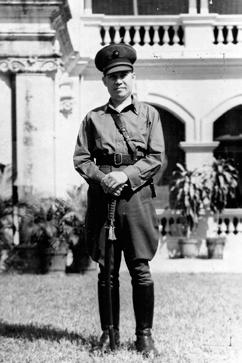
book “Burma and General Ne Win”
by Maung Maung, the Judge in Saya San’s trial, U Ba U, saw Saya San as “a thin, small man of medium size. Nobody who did not know of him
ya, Kinmimi (aunt). Front row: Mala, Tinsa, Onma, Theda, Zali Dr. Ba Maw and Daw Kinmama Maw in London on May 27, 1937would have taken him for a leader; but what he lacked in size and height, he made up for in his face and eyes. He had a strong, determined face, and his eyes glowed.”
In the same book, when asked to appeal his death sentence, Saya San was quoted as saying, “So many of my associates and followers have been killed or hanged. I should also go their way.” This showcased his defiance and indifference toward death.
But in Daw Tinsa Maw-Naing’s view, Saya San was just a “part time soothsayer and rebel king, a meek bureaucrat and sometimes medicine man” and who could have been mistaken by her father as “another petty criminal, bicycle thief or common robber” if he had not known better. He was described as not daring to utter a word even to her father who would be defending him at the trial. This version of Saya San is utterly the opposite of that presented in Maung Maung’s book.
Her view of the Thakins also diverges from the mainstream historical narrative. In Myanmar’s history, the Thakins, including figures such as Gen. Aung San, have been hailed as heroes at the forefront of the nationalist movement in the colonial



era. But through Daw Tinsa MawNaing’s eyes: “with an average age of twenty-five, these Thakins were barely out of their school greens, yawning like schoolboys when Phay Phay [her father] tried to explain to them that building a nation involved more than just blind faith in idealistic dogma.”
Her idolization of her father, Dr. Ba Maw, is readily apparent and she often compares him with others. Nevertheless, the book is still a captivating and descriptive narrative put forth by a brilliant woman who became one of the first female English lecturers in the Yangon university system in 1953. She was also resilient enough to spend a number of years at Ye Kyi Aing Detention Center, one of the most notorious in Myanmar, the first year with her four-monthold son in tow. Her crime was to have been the wife of Bo Yan Naing, who had links with the communist underground.
This memoir will resonate with many who experienced similar hardships under successive military regimes in Myanmar, from the time former dictator Gen. Ne Win led a military coup in 1962, including those who lost jobs and future prospects, who were constantly harassed by
Daw Tinsa Maw-Naing
Special Branch officers, or who, like Daw Tinsa Maw-Naing, were jailed.
A number of memoirs detailing personal struggles under Myanmar’s military regime have surfaced over the years, including, “Twilight Over Burma: My Life as a Shan Princess” by Inge Sargent, “From the Land of Green Ghosts” by Pascal Khoo Thwe, “Little
A youngDaughter” by Zoya Phan and “Golden Parasol” by Wendy Law-Yone.
But Daw Tinsa Maw-Naing’s book, co-authored with her grand-daughter Yin Min Vanessa Han, stands out for two reasons. Firstly, because the account spans such a great length of time—from the British colonial era to the Ne Win regime. Secondly, being

the daughter of Dr. Baw Maw and the wife of Bo Yan Naing, the lead author brings an insider’s view and offers fascinating, if perhaps controversial, insight into some of the country’s most notable individuals.

Daw Tinsa Maw-Naing, who died in November last year, cited the main reason for writing the book as a desire
to tell her story to younger generations. This is indeed a valuable memoir for younger people to learn from.
“A Burmese Heart” is due to be released at Myanmar Book Center on June 5, priced at 15,000 kyat. It will also be available on Amazon and as an ebook.
 By WHITNEY LIGHT / KYAINGTONG, SHAN STATE
By WHITNEY LIGHT / KYAINGTONG, SHAN STATE
As we passed through the small village of Wenpin in eastern Shan State, girls decked out in sparkling pink modern skirts and tops scampered up the hillside. A few feet back, men prodded a fat, squealing hog into following.
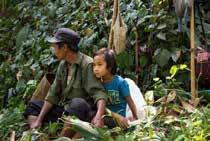

“He doesn’t want to go,” commented Sai Win. “He knows he will die.”
The Shan guide and I revised our day’s trekking route to watch the proceedings. A few hours later, we were sitting by a mountain stream watching Akha villagers prepare a feast—grilled pork, pork stew, porkrice congee, roasted pork skin and spiced blood. Meanwhile, a man split bamboo into fine ribbons and wove them into “thousand eye” motifs to mount on auspicious trees. Male elders gathered in a circle to drink a toast of rice whiskey and eat from a ritual round of dishes.
There had been no way of knowing that this day was an occasion for worshipping ancestors and appeasing forest spirits. In the Akhas’ belief system, ancestors oversee health, wealth and fertility, while spirits can wreak havoc on human life. Their rites and offerings number nine or twelve a year, although some sources say that sacrifices are made as often as once a week.
Welcomed to sit in on the event, we were privy to unique traditions in the way some “hill-tribe trekkers” probably hope for but don’t often get
in tourist hotspots. I spotted fewer than five foreign tourists (alongside busloads of Chinese visitors) in town over the course of a week.
At present, Kyaingtong (also known as Chiang Tung, reflecting its history as a former city state of the Lanna kingdom) has the charm of a seemingly remote outpost, but it has the potential to grow into a much bigger visitor spot. Many tourists today probably can’t help but wonder, with premature nostalgia, what will development look like? Can it be done ethically and sustainably? Or will it end up with gawkers parading through “human zoos,” as critics call some tourist villages of northern Thailand, while poorer
and more remote villages get no attention?
The only foreigner I spoke with during my stay was a Czech man at the bus station. We’d both just arrived after a 5-hour unairconditioned journey on coaches packed with shoppers returning from Tachileik, “City of the Golden Triangle.” He wore a technical backpack complete with a tent. In contravention of, or oblivious to, the authorities’ ban on overnight trekking, he said he was going camping in the woods but wanted a cheap guesthouse for the night.
As elsewhere in Myanmar, however, there isn’t any truly budget accommodation in Kyaingtong. The Chinese family-run Law Yee Chain Hotel where I stayed starts at US$30 per night. The carpet throughout is threadbare and nothing has been replaced in perhaps 20 years. However, the staff are diligent, the rooms are spacious and the pastel pink walls hung with faded posters of wild horses and cherubs lend a certain aesthetic.
Although you are limited by what you can do in a day, routes for a combination of travel by motorbike and on foot fan out in all directions from the city center, encompassing Aeng, Akha, Akhu, Khun and Lawa villages, stunning views of valleys and rice terraces and the sleepy old British hill station of Loimwe.
It’s enough to keep you occupied for at least four days, with some time left for exploring the city. A mountain bike would be ideal for venturing down the maze of small roads outside of town, but you would have to bring your own, as no one appears to be in the bike rental business yet.
For trekking, small groups can expect to pay a flat day-rate of about 80,000 kyat for a knowledgeable guide. Win Trekking is excellent, with 20 years of experience and sensitivity to the hill tribe cultures, including proficiency in multiple local languages. In Sai Win’s company we were welcomed everywhere for tea and chitchat. In one Aeng village, we used the local chairman’s house—a wood and bamboo box, with a porch, raised on stilts—to rest and cook lunch.
Here, while Sai Win and his students (young guides-in-training) prepared a simple feast of soup, salads and omelets, I sat with the chairman and his wife, who was suffering from a skin infection just below her right eye. The skin was black and puffed like a small balloon and she used a tissue to wipe her reddened sclera. A surgeon in Kyaingtong had tried to operate once already, Sai Win translated, and was unwilling to try again. She retrieved a tiny box of handmade items, and I bought a headscarf, wishing her robust future sales.
She was one of the few elderly
Akha people from Wenpin village near Kyaingtong honor forest spirits and ancestors with a feast, on April 7, 2015. The people sacrificed a hog and prepared various boiled and roasted dishes from it, and crafted “thousand eye” symbols from split bamboo to tie to auspicious trees.


women I met that week. At the Akha feast, small children and young women surrounded me. Few appeared over the age of 40. Some women lightly boasted of having raised between 8 and 15 children, their culture’s norm, and teased when they heard my answers to the usual polite questions. “Only one?” a few asked, meaning “Where is your family?”
The demographic reflected what the Akha Women’s Foundation reports: average life expectancy for villagers is only 43 years, on account of low access to medical care, malnutrition and harsh lives of manual labor, with few opportunities in the modern world. This description rang true in eastern Shan State, where many Akha have remained in farming villages through thick and thin, including periods soon after Myanmar’s independence when the Kuomintang and later the Communist Party of Burma were ascendant in the area.
The number of men also struck me as low, though several who had been hunting to supplement the feast emerged from the bush later on, evidently a bit downcast at returning empty-handed. Still, there was plenty to go around.
Notably, no one was dressed in the traditional Akha garb of indigo jackets and, for women, elaborate headdresses of beads and silver discs. All wore cheap, practical clothes, easily procured from Kyaingtong markets: t-shirts, cotton-print longyis for women, and trousers for men.
The scene pointed to the ridiculousness of tourists who complain to each other and in online trip forums that evidence of modernity or modified traditions is “inauthentic.”
Of course, the style of tourism that develops in eastern Shan State depends as much or more on the
Buses leave from Tachileik daily at 8:00 am and noon. Tickets cost 10,000 kyat (or 400 baht).
There are also a few airlines flying between Tachileik or Heho and Kyaingtong, for about US$50 one way. Check Air KBZ and Myanmar National Airlines for schedules.
Currently, foreigners are not permitted to travel beyond Kyaingtong overland.
Kengtung cuisine is above average in Myanmar. For breakfast, don’t miss the central morning market for a steaming bowl of soup with fresh wheat noodles or wontons, pancakes, paratha and more. For lunch or dinner, Lod Htin Lu restaurant serves wholesome Chinese food. Or, grab a fresh fruit smoothie or ice cream at Don’t Forget restaurant on the east side of Naung Tung Lake.
For centrally located, clean, low-cost rooms try Law Yee Chain Hotel (+95 84 21 114) or the Sam Yweat Hotel (+95 842 1235). Expect to pay $20-50 per night depending on the season. Sam Yweat Guesthouse (+95 84 21643) rooms can be had for $15, but it’s outside the downtown area, on Airport Road. The Princess Hotel (+95 84 21 319) is a step up, with rooms starting at $40 per night.
behavior and expectations of the people who visit (and the tour providers who indulge them), as on villagers themselves.
Yunnan Maung La Tachileik Mae Sai Chiang Rai THAILAND LAOS Kyaingtong Loimwe Xieng Kok ALL PHOTOS: WHITNEY LIGHTLong before he became world famous for his poetry, Pablo Neruda served as Chile’s honorary consul in colonial Yangon from 1927 to 1928. According to an essay he published in the Brazilian newspaper “O Cruzeiro” some three decades later, the circumstances in which Mr. Neruda arrived in the Far East were rather unusual.
“My friend gave to the minister (of foreign relations) the names of available cities all over the world, but I only caught the name of a city that I had never read nor heard of before: Rangoon,” he wrote. “The minister said to me, ‘Where do you want to go, Pablo?’ ‘To Rangoon’ I answered in a flash. ‘Put his name in,’ said the minister.”
So began Pablo Neruda’s brief but eventful one year posting, the first stop in a diplomatic career that saw him stationed in Ceylon (now Sri Lanka), the Dutch East Indies (now Indonesia), Mexico, Spain and France.
According to his writing, Mr. Neruda, who spent most of his time in Yangon living on what was then Dalhousie Street (today, Mahabandoola Road), was appalled by the British colonial occupiers who he later described as “monotonous and even ignorant.” This view was shared by many Myanmar at the time,
large numbers of whom were actively resisting colonialism with strikes and protests, all of which were put down with brutal force.
The combination of his Latin American origins and his radical politics meant that Mr. Neruda was far from the typical westerner living in colonial Myanmar. His distaste for
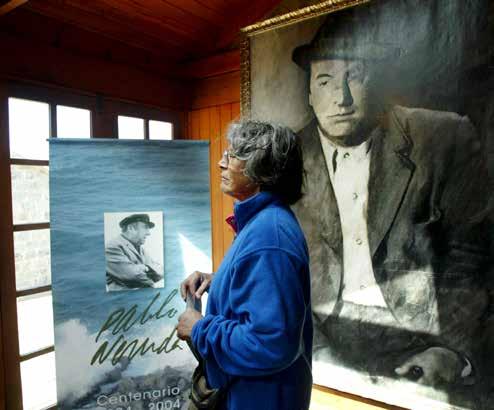
the British Empire was on full display in his poem “Rangoon 1927,” which describes both the city and the famed Strand Hotel, a popular gathering place for the colonial elite, in stark terms.
Yangon under British rule where the colonized were compelled to address the colonizers as Thakin (“lord” or “master”) was, in Mr. Neruda’s words, a place “Where a white hotel for whites / and a gilded pagoda for golden people / was as much as happened / and did not happen.”
Mr. Neruda’s aversion to the colonial overlords appears to have been mutual as, according to the poet, he was ostracized for associating with the locals, including his Myanmar lover who was the inspiration for several of his well-known poems. Being shunned by most other westerners in Yangon didn’t seem to bother the then-diplomat too much. “Those intolerant Europeans were not very interesting,” he recounted
decades later. “And, after all, I had not come to the Orient to spend my life with transient colonizers, but rather with the ancient spirit of that world, with that large, hapless human family.”
Mr. Neruda wrote evocatively of Myanmar’s bustling, multiethnic colonial capital:
“The street became my religion. The Burmese street, the Chinese quarter with its open-air theatres and paper dragons and splendid lanterns. The Hindu street, the humblest of them, with its temples operated as a business by one caste, and the poor people prostrate in the mud outside. Markets where the betel leaves rose up in green pyramids like mountains of malachite. The stalls and pens where they sold wild animals and birds. The winding streets where supple Burmese women walked with long cheroots in their mouths. All this engrossed me and drew me gradually under the spell of real life.”
However, a letter he wrote to his half-sister Laurita from Yangon gives a slightly different picture. “Life in Rangoon is a terrible exile, I wasn’t born to spend my life in such a hell,” complained the young Neruda.
His posting in Yangon was of a very low grade that didn’t even provide him with a stipend. “I lived in the greatest poverty and in even greater solitude. For weeks I didn’t see another human being,” Mr. Neruda would later recall in a 1971 interview with the Paris Review.
But being in Yangon did provide Mr. Neruda the opportunity to fall in love. Nearly all accounts of his Myanmar lover are from his own writing, and no photo or other independent records verifying her existence appear to have survived. “She dressed in the English style, and her street name was Josie Bliss; but in the privacy of her house, which I soon came to occupy, she slipped out of this impersonation and this name and reverted to an eye-filling sarong and her Burmese name.”
Mr. Neruda frequently described his relationship with Josie Bliss in dramatic terms, portraying her as an intensely jealous woman who would stalk him around the house. His 1928 poem “Tango del Viudo” (“Widower’s tango”)—inspired by an incident involving Josie Bliss, a mosquito net and a knife—is according to Neruda scholar, Jason Wilson, one of his “greatest poems.”
While Josie Bliss may have been a great poetic inspiration, her intensity appears to have been too much for the intrepid Neruda. “Sweet Josie Bliss gradually became so brooding and possessive that her jealous tantrums turned into an illness. Except for this, perhaps I would have stayed with her forever,” he wrote in “Memoirs.” Eventually Mr. Neruda headed off to Ceylon where he took up another posting as honorary consul in Colombo.
But his departure was not the last he saw of Josie Bliss.
“Quite unexpectedly, my Burmese love, the torrential Josie Bliss, planted herself at my door again. She had made the long journey to Ceylon from her distant homeland,” he wrote. “Thinking that rice grew only in Rangoon, she came with a rice-sack on her shoulders, our favorite records of Paul Robeson, and a long roll of bedding. From the front door, she proceeded to take in everything, then insulted and assaulted all who tried to get by, consumed by devouring jealousy; then she threatened to set fire to the house. One mild-mannered English lady who came to call she attacked with a large knife.”
Eventually Ms. Bliss returned home but the young Neruda found his “heart acquired a scar that has not healed.” In 1957, he returned to Myanmar for a visit but was unable to locate her. His unsuccessful search inspired another poem “Regreso a una ciudad” (“Return to a city”).
Ms. Bliss continued to influence the poet’s work for the rest of his life. In a 1964 poem titled “Amores: Josie Bliss,” Mr. Neruda recounts his deep regret for leaving the woman he had earlier dubbed his “amorous terrorist.” “I wanted to tell her that I
too / suffered: / it’s not enough: / he who wounds is wounded himself until death.”
Mr. Neruda died in Chile, just 12 days after a coup on September 11, 1973, that drove his friend, the country’s socialist president Salvador Allende, from power and installed military supremo Augusto Pinochet. The circumstances of his death, at age 69, led many close to him, including his widow and his driver, to conclude that Mr. Neruda—who was battling cancer at the time—had been secretly poisoned by General Pinochet’s henchman.
The poet’s funeral, held at his home shortly after it had been ransacked by Chilean troops, was the first act of public protest against General Pinochet’s regime.
In 2013, a Chilean court ordered that Mr. Neruda’s remains be exhumed in order to conduct forensic tests to determine if he was in fact poisoned. Although the tests proved inconclusive, the remains have yet to be reburied at the request of his family who are seeking further tests.

 UN Secretary-General Ban Ki-moon, center, and his wife Ban Soon-taek visit the housemuseum of Pablo Neruda in Isla Negra city, Chile, in March 2015.
UN Secretary-General Ban Ki-moon, center, and his wife Ban Soon-taek visit the housemuseum of Pablo Neruda in Isla Negra city, Chile, in March 2015.
Fahrenheit, in many ways, is all about the middle ground. The newly opened “craft” cocktail bar serves Mexican-fusion food, but it’s not a Mexican-themed restaurant. It is an LGBTQ friendly space, but it’s not looking to be a “gay bar.” It serves Western fare and imported beer, but Fahrenheit won’t be charging US$20 for a sandwich. Owner Jeewei summed it up when he said, “On a Friday afternoon, all the ‘diplomatic types’ can go to The Sailing Club, and the rest of us can come to Fahrenheit.”
The view from Fahrenheit’s outdoor seating on 52nd and
Bogyoke Road is definitely more chaotic than the placid lake sunsets over Inya lake, but there’s something incredibly refreshing about the casual no-nonsense vibe that’s due in part to the fact that the most dedicated waiters are the owners themselves.
The brainchild of Fab Party organizers Jeewei and two friends, Fahrenheit is dripping with personality. It has steered clear of the posh, reclaimed, colonial interiors and leather couches that are increasingly popular in downtown venues. Instead, art inspired by sign language lines the walls that have not been turned into blackboards, lending the place a cool, upscale feel that’s combined with a menu where nothing costs over US$8.
One thing that’s remarkable about the Yangon restaurant scene is how patient and understanding patrons are willing to be as venues get off their feet.

Many new players in the restaurant market are individuals with big dreams and strong friendships but little restaurant experience, and yet none of the customers around me seemed to hold that against the Fahrenheit crew despite problems with food availability and slow service.
No guacamole? No problem, the nearest table exclaimed, mentioning that the restaurant is still officially in its ‘beta’ stage. No burrito wraps for chimichangas? In my case, that meant doubling down on the tacos, and I readied myself for the series of cheesy, fried, spicy, Mexican-inspired dishes that were about to come my way.
The kitchen at Fahrenheit is headed by a lady whose culinary background is actually in French fine dining. She has embraced the challenge of making tortillas in-house and sourcing ingredients locally whenever possible. She was still smiling on a Thursday night after a
hectic week in which Fahrenheit all of a sudden became the most popular restaurant in Yangon.

Her fish tacos are definitely something to smile about. Lightly fried, served with a generous dose of Fahrenheit’s “yellow secret sauce,” they make for incredibly hearty bar food. It was clear from that first bite that the kind of cuisine this chef is aiming for is far from the gourmet delicacies of her former workplaces. Just as the venue is practical, the food is aiming for a rich quality rather than for subtlety and complexity.
Take the sweet pork quesadillas. They are absolutely satisfying in a guilt-inducing, plastic-wrappedcheese-slices kind of way. This does not sound the slightest bit appealing until you take one bite of the wonderfully balanced creamy, chewy, salty, tortilla-encased pork morsels. Once you do, it’s hard to stop.
That said, the cuisine is still a bit of a hit or miss; while the pork tacos were great, their chicken


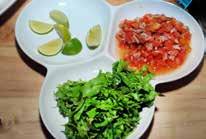
counterparts were lacking in flavor and didn’t come with rice, like the pork did, raising concerns about the reliability of the food. Will it be good sometimes and less so other times? Hopefully, this is just one of the kinks of the ‘beta’ version of Fahrenheit, which currently excels in personality and atmosphere even if the food isn’t yet stellar.
It is difficult to dole out a final verdict on a restaurant that still hadn’t officially opened when I visited. The owners clearly have a strong vision of what they’d like Fahrenheit to be, and the décor and friendliness of the staff is already making it a place to return to—not just once or twice, but often. The venue is so welcoming, in fact, that Jeewei may have been onto something when he suggested that I let others enjoy their romantic sunsets by the lake while I sip on a cold beer, nibble on some fish tacos, and watch the day turn slowly into night among the chaotic, noisy rumblings of downtown.
Sanjay Kumar, a professional yoga therapy trainer, works at the Embassy of India in Yangon which offers affordable yoga courses for various levels of proficiency. The courses are intended to foster a “healthy relationship” between Myanmar and India and three styles of the ancient art are offered; Ashtanga, Hatha and Bihar yoga. The Irrawaddy recently spoke with Mr. Kumar.
Are local people interested in yoga? Who is attending?

Our classes are open to anyone. Most participants are Myanmar people, but others also come, including Chinese, Austrian, Japanese, Singaporean, Italian, French and Americans. Everybody can join.
When I came here, there were 125 students. Now there are about 250 to 300 in eight classes at the beginner and advanced levels. Most people come for health reasons, to keep fit and have peace of mind, to do well in their jobs.
What are the main health benefits?
The people who come here have very different problems. Some have back pain, others have neck pain. Some are obese. Sometimes they are stressed; their lives feel hectic, they
have too much work. They can’t sleep at night. After practicing yoga for one or two months, they thank me for solving their problems.
How is yoga helping the embassy to build a “healthy relationship” with Myanmar?

We are approaching the common people, it’s easy to connect. They come here and they feel better. The Indian Embassy only charges US$5 per month [5,000 kyats]. We are helping Myanmar people with their

health and supporting them to keep fit and to feel fresh.
Do many people tell you about their health problems?
Many people taking the class tell me about their problems. More than 30 percent. They also tell others to do yoga.
Why should people try yoga?
I think everybody should learn yoga. It is preventive of future ailments. If people practice regularly they will have better health in the future. If you have time for half an hour, practice half an hour. If you have time once a week, practice weekly. This is not linked to religion. This is yoga for everybody, yoga for all. In the yoga textbook, it says, “Whether young or old, very old, sick or feeble, one can attain perfection in yoga by practicing.” Everybody can practice. Those who want to achieve spiritual power can also practice.
